

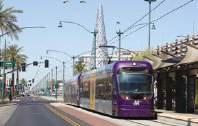












Stadler is at the forefront of green technology. We produce trains powered by battery, which can replace diesel and operate on lines not fitted with electrical supply systems.
stadlerrail.com
See us in booth H at the UKLRC 2025!
Most organisations in the light rail sector are members of CIRAS. We build a strong listening partnership with our members to improve safety. Our confidential safety hotline provides extra listening to help staff make the right call and report their concerns even when they feel they can’t use other channels. When we listen, we learn.
Learn how you can build your listening partnership with CIRAS at ciras.org.uk/rightcall.

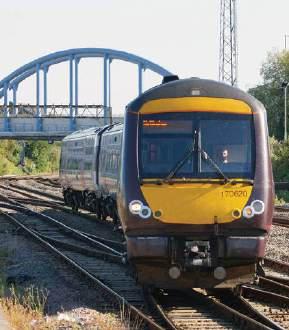
NEWS
288
Work on Vienna extension gets underway; First Turkish tram arrives in Belgrade.
UK SPENDING REVIEW
292
TAUT delves into the detail of where the billions promised in the recentlyannounced UK Spending Review will go.
UITP REPORT
294
Geoff Butler summarises this year’s event.
PHOENIX LAUNCHES
297
Valley Metro launched its South Central extension in June – Andrew Grahl reports on the opening.
CHINA METROS: PART TWO
299
Hans Ulrich Riedel continues his overview of metro plans in China, this time focusing on the burgeoning Pearl River Delta.

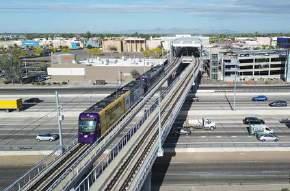
MIDLAND METRO ALLIANCE 304
Exploring the benefits of a working alliance.
NEW LRT f OR BELGIUM : LI È GE 306 Liège celebrated opening its first tramway in April; Andrew Thompson explores.
S y STEMS fACT f ILE : SAINT-É TIENNE 309
With a modern fleet and tailored network, this French city runs very smoothly indeed.
WORLDWIDE REVIEW
Bangkok invites tenders for the Red Line; Vienna receives its last Alstom Flexity
THE 2025 LIGHT RAIL SUMMIT
Looking ahead to this year’s event.
CLASSIC TRAMS: PAULO MARq UES
Mike Russell visits a private museum collection in Lisboa, Portugal.

We could only be 18 months from the start of construction of the UK’s first brand new city light rail system for two and a half decades.
315
319
320
After so many dashed hopes and promises, the GBP2.5bn (EUR2.9bn) West Yorkshire scheme heralds a great economic future for the twin cities of Leeds and Bradford, and the surrounding towns, that collectively make up a population of 2.3 million people.
It will be a great pleasure to be in their company at the 19th Annual Light Conference at Leeds University, when we will be hearing from other systems that are achieving high ridership figures and are optimistic that UK light rail has turned the corner in gaining government confidence. New tramways need not cost the earth either, as the promoters of Coventry Very Light Rail are happy to share with us, in the sure hope that cities of the same size might also get a look in.
At another conference, the UITP gathering in Hamburg, speakers shouted from the rooftops that addressing climate change hasn’t gone away. You can read in this issue how nations across the globe are coming together to try to achieve rapid change, and all of them are asking whether the United States under President Donald Trump will play ball.
As we went to press, we learned of the death on 30 June of Geoffrey Claydon, Patron of the LRTA and an active member and contributor to this magazine for a remarkable 79 years. We will cover Geoffrey’s life in more detail in a future issue, paying tribute to the influence and impact he had in the shaping of our new generation of UK tramways.
Matt Johnston, Editor
COVER: Changchun Railway Vehicles Type B 0338 arriving at Shenzhen Metro Line 3 Buji station in Longgang District on 22 April 2025. Neil Pulling
AUGUST 2025 Vol. 88 No. 1052 www.tautonline.com
EDITORIAL
Editor – Matt Johnston matt@mainspring.co.uk
Associ At E Editor – Tony Streeter tony.streeter@mainspring.co.uk

WorldW id E Editor – Michael Taplin miketap@mainspring.co.uk
sEN ior c o N tributor s –Howard Johnston , Neil Pulling WO r L dW id E C ONT ri B u TO r S r ichard Foster, Andrew Grahl, Andrew Moglestue, Herbert Pence, Mike russell, Nikolai s emyonov, Alain s enut, Andrew t hompson, Witold urbanowicz, bill Vigrass, t homas Wagner, Philip Webb.
Productio N – Lanna Blyth tel: +44 (0)1733 367604 production@mainspring.co.uk
d E si GN – Debbie Nolan A Dv ERTI s I ng
co MME rci A l M ANAGE r – Geoff Butler tel: +44 (0)1733 367610 geoff@mainspring.co.uk
Tramways & Urban Transit 13 o rton Enterprise centre, b akewell road, Peterborough PE2 6X u u K
Tramways & Urban Transit is published by Mainspring on behalf of the lrtA on the third Friday of each month preceding the cover date.
LRTA MEMBERSHIP (with TAUT subscription)
Tramways & Urban Transit is sent free to all paid-up members of the l ight r ail t ransit Association.
lrtA WE bsit E AN d di A rY Tim Kendell webmaster@lrta.org meetings@lrta.org
sU bsc RI p TIO ns, MEM b ER s HI p A n D b Ack I ss UE s lrtA Membership s ecretary ( d ept t06), 38 Wolseley road, s ale M33 7Au, u K. tel: +44 (0)117 951 7785 membership@lrta.org Website: www.lrta.org f OR c OR p ORATE sU bsc RI p TIO ns v I s IT www.mainspring.co.uk
LRTA REGISTERED Off ICE 13 o rton Enterprise centre, b akewell road, Peterborough PE2 6X u, u K Private company limited by guarantee, No. 5072319 in England and Wales.
lrtA cHA ir MAN – Paul Rowen chair@lrta.org
© lrtA 2025
Articles are submitted on the understanding they may also be used on our websites or in other media. A contribution is accepted on the basis that its author is responsible for the opinions expressed in it, and such opinions are not those of the LRTA or Mainspring. All rights reserved. No part of this magazine may be reproduced or transmitted in any form by any means, electronic or mechanical, including photocopying, recording or by any information storage and retrieval system, without prior permission in writing from the copyright owner. Multiple copying of the contents of the magazine without prior written approval is not permitted.
t he Manson Group l
Alstom grows US plant
Alstom has built a new 12 541m 2 stainless steel bodyshell production facility at its plant at Hornell, about 145km (90 miles) southeast of Buffalo, New York. Known as Plant 4, the USD75m (EUR64m) facility opened on 2 June. It is expected to support 258 new employees. Alstom previously sourced its stainless steel bodyshells from Brazil.
Plant 4 will play its role in building 316 new M-9A commuter trains for New York’s Metropolitan Transportation Authority. The contract was endorsed by MTA’s finance committee on 23 June.
The first trains are to be delivered in 2029, with the order to be completed in 2032. The trains are to be split: 160 cars to go to Long Island Rail Road, with 156 allocated to the Metro-North Railroad. Illinois to restructure?
The Illinois House of Representatives (US) is considering a bill that would replace the Regional Transportation Authority with a new organisation, the Northern Illinois Transit Authority. This would be responsible for creating a universal fare system and co-ordination of revenue and capital projects.
Should NITA come into existence, it would leave Chicago Transit Authority, Metra and Pace Bus purely as operators of their respective light rail, heavy rail and bus systems. NITA’s board would comprise 20 directors, with the counties of Kane, Lake, McHenry, DuPage and Will appointing one director each.
However, State Senator Don DeWitte told WTTW television:
“[This] appears to confirm our initial fears that this is a Chicago –Cook County takeover of regional transit funding and operations because the voting thresholds appear to be heavily skewed toward Cook County and the City of Chicago.”
The NITA bill also makes no attempt to address the expected USD770m (EUR657m) budget deficit for transit services in 2026 once COVID relief funding expires.
Illinois Governor J.B. Pritzker said: “The answer is not that the state is solely responsible for filling that gap. There are lots of sources… as well as efficiencies that need to be brought to the system.”
New tram depot for Berlin Berlin is to get its first new depot in 40 years. It has taken four years to obtain planning permission for the EUR120m tram depot and workshop at Adlershof in the German capital, but the 50 000m 2 site will be able to maintain and repair up to 60 vehicles.
Operator Berliner Verkehrsbetriebe (BVG) hopes to start work on the depot in 2026; the facility is expected to open in 2030. The tramway on Dörpfeldstrasse will need to be doubled in order to improve access to the depot.
Aground-breaking ceremony for the line 18 extension in Wien (Vienna) took place on 3 June. The 3.1km (1.9-mile) line will link the existing terminus of the Austrian capital’s line at Schlachthausgasse to an interchange with metro line U2 at Stadion (Handelskai).
New track will be laid in Meiereistrasse and Stadionallee, including 70m of grassed track near Ernst Happel Stadion. There will be seven new tram stops and the line is due to open in autumn 2026. The project also includes building 2150m of new cycle lanes.
Ulli Sima, City Councillor for
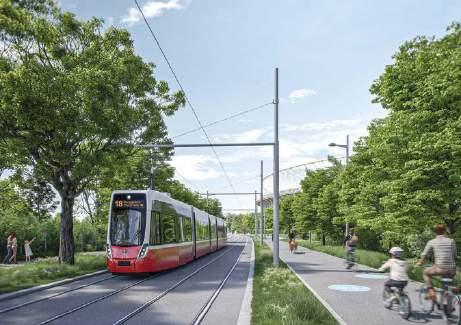
Planning and Mobility, said: “We are further expanding Vienna’s public transport network to be climate-friendly, efficient and future-proof.
“I am particularly pleased that, with this tram project, we are not only strengthening public transport, but also creating new bike paths, planting 200 new trees, and reducing traffic in the green Prater.”
Gudrun Sen, Managing Director of Technical Services at Wiener Linien added: “Six million passengers will benefit from this on line 18 in future. By shifting travel from cars to public transport, up to 1300t of CO2 can be saved annually.”
The extension will connect new urban development areas at Viertel Zwei, Schnirchgasse/ Triiiple, Eurogate and Sonnwendviertel as well as serving the new long-distance bus terminal at Stadion Center. It will also provide an alternative route to the S-Bahn, connecting St Marx with the east of the city, as well as taking over from bus line 77A.
Alstom delivered the first of 39 new Citadis trams to Strasbourg’s Kibitzenau depot on 5 June.
The vehicles are to carry their first passengers on the French network this November.
Operator Compagnie des Transports Strasbourgeois ordered the trams in 2023; seven are due to work the new line to Wolfisheim when this opens in December. A further 12 are due to arrive in 2026. They are also able to cross the River Rhein (Rhine) on Line D to reach Kehl in Germany. Eventually, they will enable the last remaining British-built Eurotrams to be withdrawn.
These Citadis vehicles are 45m long, with four-sections. They are 2.4m wide, feature rotating bogies, and are air-conditioned.
The first is now being fitted with onboard equipment including an operational assistance system, prior to the start of testing. The new
vehicles are 20% more energyefficient than the previous batch, incorporate LED lighting, and are built to be 95% recyclable.
A new feature is enlarged glass surfaces to improve passengers’ perception of safety and comfort.
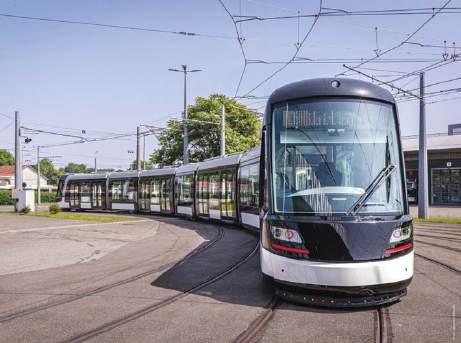
Romania’s 22km (14-mile) interurban tramline between the city of Arad and the town of Ghioroc closed on 26 May for a three-year programme of modernisation. This was slightly earlier than the originally-planned 2 June closure date, due to a substation fire.
Reopening is due to take place in 2028. However, the modernisation programme is not yet funded and some commentators have questioned whether the work will be completed in time, even if EU funding can be found.
The system dates back to 1913 when a three-line 57.5km (36-mile) electrified light railway was opened around the town of Ghioroc. Until 1965, this 1500V dc system was Romania’s only electrified railway. It was extended and upgraded as a tramway in 1977 in connection with the creation of a chemical plant. Through running to Arad city centre started in 1982.
Closures started after the collapse of communism in 1989. Just the Arad – Ghioroc service remains, running as interurban lines 11 and 12. They have an

hourly service.
Arad’s city tramline to Strada Făt Frumos reopened on 2 June. The network now comprises the following routes:
• 1: Strada Făt Frumos – Piata
Podgoria – Piaț a Romană
• 1b: Strada Făt Frumos –
Zona Industrială Arad Vest
• 3: Strada Făt Frumos – Piata
Podgoria – Gara Artadul Nou
• 6: Piaț a gai – Piaț a Uta –
Piaț a Romană
The light rail operator in the German city of Saarbrücken unveiled the first of its Stadler tram-train vehicles on 9 June. It should carry passengers by the end of the year.
Saarbahn is one of six operators that have collectively ordered more than 500 of these cars. It is to take 28, with an option for 21 more. The contract includes 32 years of maintenance.
Each 37.2m double-ended low-floor car has three body sections and four bogies, with four double doors each side. Inside the 2.65m wide bodies are 100 seats and space for up to 133 standing passengers. There are two multipurpose areas with space for bicycles and strollers as well as reserved areas for wheelchair users. The tram-

• 7: Strada Făt – Piaț a Uta –
Piata Podgoria – Piaț a Romană –
Strada Făt Frumos
• 15: Strada Făt Frumos –Gara CFR – Sere
• 16: Piaț a Romană –
Piata Podgoria – Sere
• 18b: Strada Făt Frumos –Piaț a Uta – Piaț a Romană –
Piata Podgoria – Strada Făt Frumos
Only a limited service is provided on lines 1 and 1b.
Alstom has selected the GMV intelligent transportation system for the 22.4km (14-mile) AlUla tramline in Saudi Arabia. This multi-application computeraided dispatch/automatic vehicle location platform will provide tram operation and management capabilities.
GMV has already supplied similar systems to Barcelona, Warszawa (Warsaw) and Sydney. The system allows the operator to perform integrated transport management, including planning and monitoring of services and fleets in real time, providing passenger information and using recorded data for statistical purposes.
The AlUla tramway project is planned to immerse its passengers in a cultural journey through five historic districts and 17 stations, partly using the trackbed of the historic Hejaz railway. Phase one should be operational by the second half of 2027.
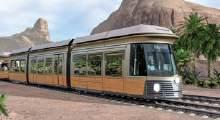
Washington D.C. Mayor Muriel Bowser has announced that the budget for operating the Washington Streetcar will not be extended beyond 2027. Costing USD10m a year to operate, the US line is to be replaced with electric buses.
The 3.5km (2.2-mile) route was approved in 2002, with tracks being laid in 2007-11. However, the USD200m (EUR171m) scheme did not open until February 2016.
Intended by the previous administration to be extended as part of a larger network, the free-
to-use line carries about 2300 people per day. Its route from Union Station along H Street to Oklahoma Avenue at the west end of the Anacostia bridge is duplicated by express buses.
Operated by RATP Dev, the line has a mixed fleet of six 20.1m, three-section, low-floor trams. Of these, three are Inekon Trios, built in the Czech Republic in 2009, with the other three being Skoda 10Ts built under licence by United Streetcar in 2014. They work from what was meant to be a temporary depot on a former school site.
trains run using 750V dc on tram lines and 15 000V ac on railways. Power comes from six 125kW motors, and the maximum speed is 100km/h (62mph).
Operators VBK Karlsruhe, AVG Karlsruhe, and Neckar-Alb Regional-Stadtbahn have also placed orders for these vehicles, as have RSB Salzburg and Schiene Oberösterreich in Austria.

Transport for London has launched a second public consultation into its planned Docklands Light Railway extension to Thamesmead.
The 3km (1.9-mile) line in the UK capital would diverge from the existing system just to the north of Beckton depot before swinging east, through the proposed Beckton Riverside development area. It would then pass under the River Thames to Thamesmead, which is between the Boroughs of Greenwich and Bexley.
The first public consultation took place in 2024. Now TfL is seeking public opinion on the route, the impact on the environment and “on the wider transport network and nearby communities”, and how construction could take place. Consultation ends on 17 August.
Although the Spending Review guaranteed regular funding for TfL (see page 292), London Mayor Sadiq Kahn voiced his disappointment that projects such as the Thamesmead and Bakerloo extensions were left unfunded.
Meanwhile, a new DLR timetable is to come into effect on 21 July. This is to enable maintenance of the existing train sets during the summer months. It should also pave the way for the introduction of the first CAF B23 trains.
The first of the new vehicles were unveiled to Londoners in 2023. However, TfL Commissioner Andy Lord said: “We remain on track to introduce the first new train later this year and replace the B92 fleet by the end of 2026 as planned.”
The Piccadilly Line’s 1973 Stock has been reprieved after Transport for London confirmed that the new 2024 Stock for the UK capital’s Underground will not enter service until late 2026.
Sambit Banerjee, Joint CEO at Siemens Mobility, said: “We’re sorry we can’t have our innovative trains running for passengers even sooner but, once they’re in service, the technology on these new trains will bring smoother, greener and more comfortable journeys for Londoners for the next 30 or more years.”
The first Bozankaya-built tram has arrived in Beograd (Belgrade), less than a year after the EUR73.5m order for 25 trams was placed with the Turkish company. It was delivered by road to the main GSP Beograd depot on 29 May.
These five-section, 30.5m trams are 80% low-floor. They are to carry a new blue livery.
The Serbian capital’s 43.5km (27-mile) metre-gauge tramway dates back to 1892 and is in need of modernisation. Its fleet comprises 100 high-floor Tatra KT4YU trams, which are over 30 years old, and secondhand high-floor trams from the Swiss city of Basel that are older still. In addition, there are 30 fivesection CAF Urbos low-floor trams. An order for 100 new trams with Astra Vagoane was cancelled (TAUT 1051).
Free travel was introduced across the city’s tram, bus and
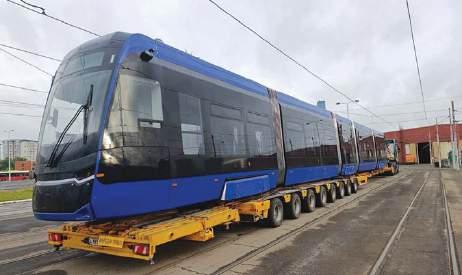
network in January
in a bid to reduce fare evasion. However, this has since led to overcrowding. Compounding the issue is that the city is to hold a world exposition in 2027. Commentators have suggested that the new, two-line metro is unlikely to open before 2030, especially as the deal for two
tunnel-boring machines was only signed with China Railway Construction Heavy Industry Corporation Limited in May. In addition, public protests persuaded the city council to rescind its autumn 2024 decision to withdraw the city’s trolleybus fleet. However, the fleet of BKM-built vehicles requires replacement.
Los Angeles’ new LAX/Metro Transit Center station (US) opened as planned on 6 June (TAUT 1051). As well as Metro C and K light rail lines, it serves Metro bus lines as well as bus routes from other transit
authorities from its 16-bay bus plaza. The new facility includes a secure bike hub and a customer service centre.
Open 04.00-00.30 daily, the station can accommodate 5000 passengers per hour at peak
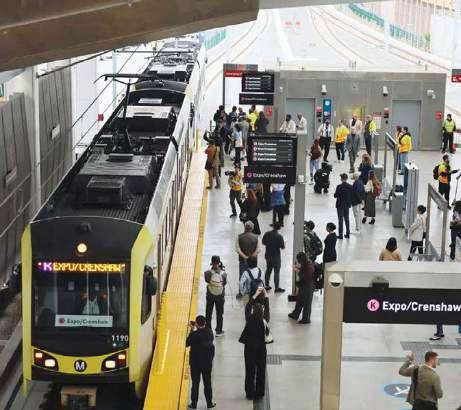
periods. Its light rail platforms are the widest on the Metro system.
The centrepiece of the new station is The Distance of the Sun, a sculpture by artist Glenn Kaino representing an imagined spacecraft.
The USD898.6m (EUR767m) project is part of enhancements to the region’s transit infrastructure in advance of the 2026 FIFA World Cup football, which is to be followed by the 2027 Super Bowl and 2028 Olympic and Paralympic Games.
Los Angeles Mayor Karen Bass said: “This immensely important improvement required investment and co-ordination across multiple levels of government. We are delivering the results that the people of Los Angeles have demanded and world travellers have waited for.”
Coventry’s Very Light Rail pilot scheme is to be extended thanks to GBP12m (EUR14m) of UK Government money, while the first potential routes for a network have been identified.
Councillor Jim O’Boyle said the money will be used to extend the current 220m demonstration line on Greyfriars and Queen Victoria Roads across the A4053 ring road to the Coventry University Technology Centre.
He told the BBC that the move “means we can then further demonstrate how the vehicle works in a real-life environment and eventually we aim to have a track system... [with] the first route by 2027.”
The demonstrator, which started running on 30 May, received high-profile visitors on 18 June in the form of West Midlands Mayor Richard Parker and Local Transport Minister Simon Lightwood. The visit coincided with the Campaign
for Better Transport’s ‘Better Transport Week’.
Mayor Parker said: “This successful trial… paves the way for the quick delivery of a network in Coventry and has the potential to revolutionise public transport for millions worldwide.”
Simon Lightwood added that VLR “shows how innovative approaches to transport ideas can drive growth, create highskilled jobs, and breathe new life into our towns and cities.”
The council has since published the six potential destinations for what could become a VLR system. They include Coventry University Technology Park, Coventry railway station, Coventry Airport (south of the city), University Hospital and Ansty Park (to the east), and the University of the Warwick (to the west). The total cost of the system is estimated at GBP189m (EUR222m).
Arab Contractors and Hassan Allam Construction have won the contract to rebuild the Raml tramway in Al Iskandariya (Alexandria). Dating back to the 1860s, the 13.6km (8.5-mile) east-west line suffers from ageing infrastructure, with journey times of 60 minutes.
The Raml Tram Rehabilitation Project is part of a wider plan to make the Egyptian city’s transport more environmentally friendly. The scheme aims to reduce the Victoria – Raml journey time to 35 minutes and to improve headways from nine minutes to three minutes.
The revamped line will comprise 5.7km (3.5 miles) of surface running, 7.3km (4.5 miles) of elevated line and
a 276m tunnel. An extension from Raml to Mansheya Square will bring its total length to 14.5km (nine miles). The 24 existing stops will also be refurbished and Hyundai Rotem is to supply 30 new trams.
Meanwhile, National Egyptian Railway Industries Company (NERIC) has won a EUR275m contract to supply 21 nine-car trains for the future 21.7km (13.4-mile) metro line. The deal includes ten years of maintenance.
NERI has built a new 300 000m 2 production facility at East Port Said in partnership with HyundaiRotem. The EGP4.2bn (EUR72m) plant already has an order for 40 eight-car trains for Cairo.

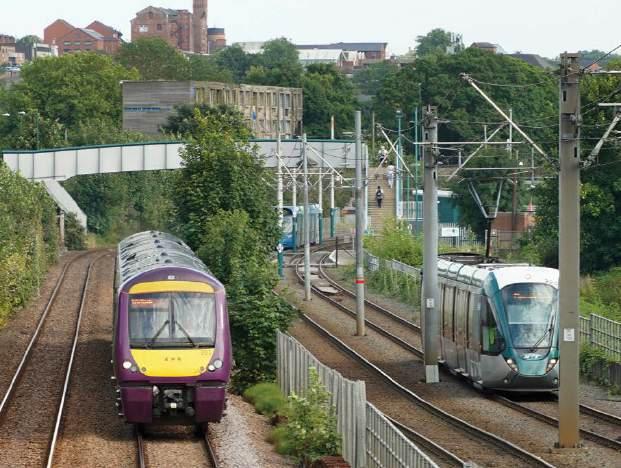
an enormous investment in uk infrastructure was announced in June, with a focus on light rail. TAUT delves into the finer details.
Fifteen point six billion pounds.
That’s what UK Chancellor Rachel Reeves committed to transport projects around the country on 11 June, in the Government’s Spending Review. The good news is that most of it is destinated for projects in the light and urban rail sector. On top of that, money was committed to securing Transport for London’s finances.
The GBP15.6bn (EUR17.8bn) investment was made in advance of the Spending Review on 4 June, to positive headlines. Feedback from the metro mayors was equally positive.
Yet it certainly caused a few raised eyebrows because, if the news is to be believed, the UK’s finances are not in the healthiest state.
Sir Keir Starmer became Prime Minister on 5 June 2024 and, weeks later, his Government was talking about GBP22bn (EUR26bn) “black holes” in public finances, which were blamed on the previous Conversative government.
It’s probably worth taking a look at the difference between the Budget and the Spending Review at this juncture. The Hansard Society offers succinct descriptions: “Unlike the Budget, which is focused on raising money (primarily through taxation), the Spending Review is about how that money will be allocated across government departments and programmes.”
Unlike the Budget, which is debated beforehand and then becomes the Finance Bill, the Hansard Society says that a Spending Review has “no immediate parliamentary approval procedure”.
It’s also important to note that the Spending Review only covers England. The UK Chancellor allocates funds to the Scottish, Welsh and Northern Irish governments and it is up to Holyrood, Cardiff and Stormont to decide which transport projects get backing.
“What the Chancellor has done is effectively announced a re-start of the programme that the Conservatives had launched with Network North.”
The UK Government called the Spending Review the “biggest ever investment in city region local transport”. The projects the Review listed are not set in stone, but are those “likely to be taken forward by mayors”. So what projects are we talking about?
• Greater Manchester Combined Authority: GBP2.5bn (EUR2.9bn) to cover myriad projects, including buying new electric buses and incorporating heavy rail services into the Bee Network. Light rail-specific projects include extending Metrolink to Stockport Interchange, which opened in March 2024 with provision for trams incorporated. It also includes paying for the Pathfinder project,
the East Midlands is set to receive Eur2.3bn for improving services between Derby and nottingham, which forms the ‘trent arc’ – pictured are heavy and light rail vehicles near David lane in nottingham. All images courtesy of
a tram-train network link between Bury, Heywood, Rochdale and Oldham that utilises both Network Rail metals and those of the East Lancashire Railway.
• North East Combined Authority (NECA): GBP1.8bn (EUR2.1bn) for connecting Washington to the Tyne and Wear Metro. This would involve re-opening part of the mothballed Leamside Loop, as well as building a new formation east from Washington to connect to the Metro at South Hylton.
• South Yorkshire Mayoral Combined Authority (SYMCA): GBP530m (EUR621m) of its promised GBP1.5bn (EUR1.8bn) is going to be used to upgrade Supertram, the programme of work including track renewals and procuring new stock.
• West Midlands Combined Authority (WMCA): GBP2.4bn (EUR2.8bn) for extending West Midlands Metro from Birmingham City Centre to a new ‘Sports Quarter’.
• West Yorkshire Combined Authority (WYCA): GBP2.1bn (EUR2.5bn) to start West Yorkshire Mass Transit construction by 2028 and have it open in the 2030s. The money is also planned to be used to improve transport corridors not covered by proposed mass transit routes.
Two further announcements include money that could be used to develop mass transit solutions in areas that have long called for them. GBP200m (EUR235m) of West of England Combined Authority’s promised GBP800m (EUR938m) is set to go towards developing mass transit solutions between Bristol, Bath, South Gloucestershire and North Somerset. East Midlands Combined County Authority is to receive GBP2bn (EUR2.3bn) for improving transport services in what’s called the Trent Arc, between Derby and Nottingham. Funding could be allocated to the design of a new mass transit solution between the two (plans for a tramway were rejected by the government in 2019).
Funding was also announced for both Tees Valley Combined Authority and Liverpool City Region Combined Authority; the former is to invest some of its GBP1bn (EUR1.2bn) in transforming Middlesbrough railway station, while the latter looks set to invest its GBP1.6bn (EUR1.9bn) in bus-related schemes.
As mentioned, the pressure is off Transport for London (TfL) as it has agreed a regular funding plan, similar to Network Rail’s fiveyear funding plans, known as Control Periods. Previously, TfL has had to rely on negotiating with UK government directly for funds.
London’s Transport Commissioner Andy Lord said, “We are pleased that, together with our suppliers, we can move on from the shortterm and stop-start nature of funding over recent years and get on with the vital work of making our city and our country work for everyone.”
That’s all positive stuff and could lead to a significant re-drawing of England’s light
railway map. But scratch below the Spending Review headlines, and it maybe doesn’t go far enough.
For example, SYMCA’s Executive Director of Transport Melanie Corcoran said in TAUT 1043 that expanding the network was the “number one thing” that the public wanted from public ownership of Supertram. Expansion proposals include a new city centre loop and extending tram-train operations northwest to Stocksbridge and south towards Chesterfield.
As recently as April, Dr Marie Tidball, MP for Penistone & Stocksbridge, renewed calls for Sheffield Supertram to be extended north into her constituency. The Chancellor replied (Hansard HC Deb., 9 April 2025), “The Chief Secretary is working closely with mayors, including Oliver Coppard, to understand their priorities for the places they represent at the Spending Review in June, and will continue that work.”
However, the Spending Review included no provision for expanding the network. In response, an SYMCA spokesperson told TAUT: “The allocation includes a critical investment in the renewal of our region’s mass transit system. That renewal programme is the cornerstone of our plans to modernise the tram system, meaning both new track and rolling stock, while also laying the foundation for future network expansion.
“While detailed costs are still being finalised, we have already secured GBP100m [EUR1.17m] through the CRSTS1 [City Region Sustainable Transport Settlements 1] programme towards the renewal, which will be integrated into the wider regional funding settlement. We continue to engage with the government on vital funding we need for a tram extension to add further stops and routes to our network.”
Meanwhile, campaign group BusinessForBakerloo was unhappy that TfL’s funding settlement only goes so far. It said, “BusinessForBakerloo welcomes the Government’s decision to allocate GBP2bn [EUR2.34bn] of funding… for Transport for London’s capital renewals programme. However, this does not include allocated funding for the full upgrade and extension of the Bakerloo Line, a long-standing priority for London and a project with clear economic, environmental and social benefits.”
The USD64 000 question – or should that
be the GBP15.6bn question? – is: does this represent a genuine investment in local public transport, or is it simply previouslyannounced money with a new name?
The metro mayors receive money for transport projects from City Region Sustainable Transport Settlements. CRSTS1 promised seven combined authorities GBP5.7bn (EUR6.7bn) between 2022-23 and 2026-27. CRSTS2 payments – totalling GBP8.8bn (EUR10bn) – would cover the 2027/28-2031/32 period.
But then Prime Minister Rishi Sunak cancelled Phase 2 of the controversial high speed railway line, HS2, in October 2023. In the wake of this came the GBP36bn (EUR42.2bn) ‘redistribution’ of HS2 funds in what was called ‘Network North’. In practical terms, the money would come via increased CRSTS2 settlements.
Some of what Network North included sounds rather familiar: funding for West Yorkshire Mass Transit, funding for expanding Metrolink, funding for developing mass transit around Bristol, and funding for developing mass transit between Nottingham and Derby.
As Richard Bowker explained on the railway podcast Green Signals, the incoming Labour effectively paused CRSTS2 funding while it carried out a review into public spending in order to fill the GBP22bn (EUR25.8bn) ‘hole’ in public finances. This led to measures such as ending the ‘Restoring your Railway’ programme.
“What the Chancellor has actually done is effectively announced a re-start of the programme that the Conservatives had launched with Network North,” he said. “Post-Rishi Sunak’s decision in October 2023, the CRSTS2 settlement [for West Yorkshire] was uplifted to GBP2.1bn (EUR2.5bn). And yet following the Chancellor’s announcement last week, the now re-branded Transport City Region settlement for the same period… was GBP2.1bn. And it’s the same for pretty much every region.”
David Leeder, Managing Partner of global transport consultancy firm Transport Investment Limited, shares this view. However, he adds that the results of the 1 May local/mayoral elections may have influenced the Spending Review.
“To be fair to the Government,” he told Green Signals, “the reason that they did the
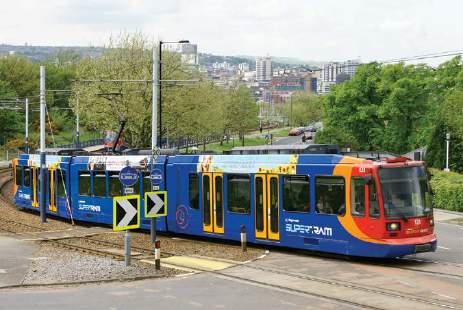
pause… is that there’s a big public spending problem. But it looks to me that the way they just reinvented this list is in response to the terrible election results.”
Infrastructure projects such as building a new tramway have had to go through three phases: Strategic Outline Case (SOC), Outline Business Case (OBC), and Full Business Case (FBC). They generally also have to demonstrate a positive Benefit: Cost Ratio (BCR).
However, in the case of the West Midlands Metro’s Eastside Extension, West Midlands Combined Authority was recommended, during a board meeting on 9 May, to approve the Business Case Refresh for the Eastside Extension. In fact, as we reported in TAUT 1051, Mayor Richard Parker had already ‘fast-tracked’ GBP62m (EUR74m) in order to accelerate the Phase 2 construction process, so that it could take advantage of the GBP100m (EUR119m) redevelopment to the east of Digbeth that’s dubbed the ‘Sports Quarter’.
A report from WMCA’s 9 May meeting said, “Analysis also found that the economic costs of the scheme were negative. Because the cost is negative, it is not possible to generate a BCR but the Department for Transport Value for Money Framework defines this scenario as having a “Very high (and financially positive)” value for money.”
Many of the headlines following the Spending Review claimed that such-andsuch a scheme “WILL happen”. But does the promise of money mean that the cheque is metaphorically on its way and developing Business Cases is no longer needed?
Speaking to TAUT, Bowker doesn’t think so. Under CRSTS, schemes would needed to go through the three stages.
“That is what is still in play,” he says. The rules might change under TCR, he thinks, but schemes might move to district auditors rather than central government.
“You’ll have to have a business case [to ensure that a scheme] still stands up to scrutiny.”
There’s no doubt that the Spending Review has thrust light rail into the public eye and that it has generated a great deal of excitement in parts of the country promised the money and new lines.
But whether we’ll have spades in the ground remains to be seen.

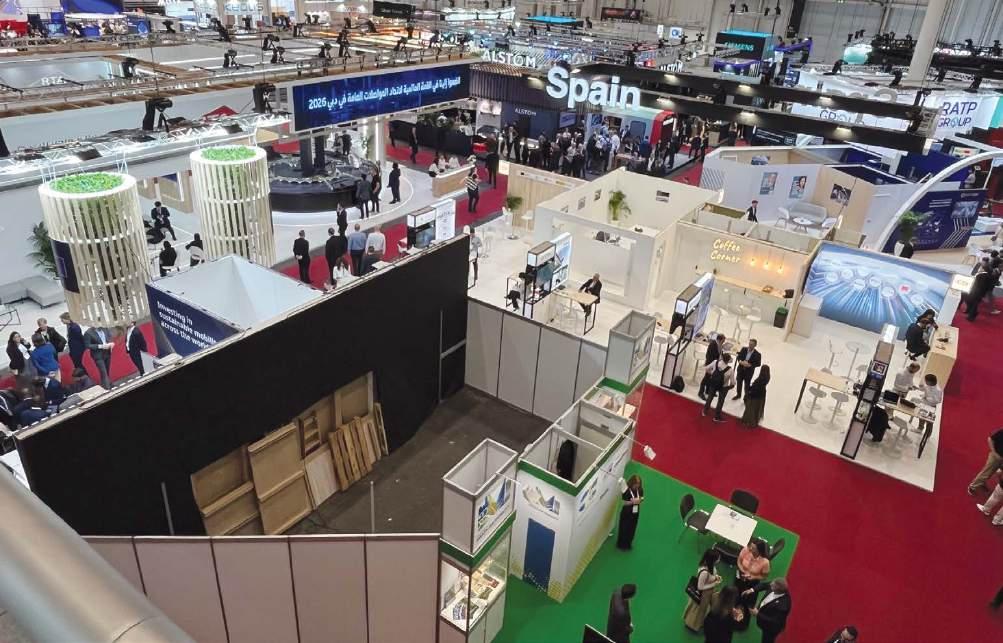
geoff butler reports from the 2025 uitP summit, where the world’s public transport leaders meet and share ideas.
While some nations have followed the United States recently by pushing the issue of climate change down their agendas, the thousands that attended this year’s International Association of Public Transport (UITP) Conference in Hamburg from 15-18 June are certainly not amongst them.
More than 10 000 people went to the summit, and the 300-plus exhibitors and 340 speakers showed how much interest there is in securing better quality public transport in the right way.
UITP has had a long association with Hamburg. Opening the event, Dr Anjes Tjarks, Minister for Transport and Mobility Transition, said the first UITP visit was held in 1981, and it will be back again in two years’ time.
The city is on course to become climateneutral by 2045, offering residents and visitors attractive alternatives to cars. Dr Tjarks said that CO2 emissions will be reduced by building 34 new S- and U-Bahn stations, advancing digitalisation, and integrating autonomous shuttles.
Public transport is championed as an answer to many of the challenges the world faces, including managing the climate. Dr Tjaerks praised Hamburg for showing that sustainable mobility can be at the centre of urban life. She said: “It is not just about systems and schedules, it’s about people. Leadership in public transport must reflect the communities we serve.”
In her keynote speech, Benita Matofska, author and changemaker, inspired attendees with her seven ways to achieve positive
change. The most important skill is having the ability to change. As well as being adaptable, being people-friendly, and celebrating success, they are not only good for business, but also for sustainability. The benefits then have to be sold to everyone. She said: “To change the world, we need to change the narrative... Over 95% of what we hear daily is negative. Optimism and positivity drive change… positivity empowers and shifts people from feeling helpless to feeling they can make a difference.”
“To change the world, we need to change the narrative... Optimism and positivity drive change.”
At the breakfast session, focusing on the practical implementation of European mobility models in Mexico and other Latin American countries, speakers reiterated how regional differences must be taken into account. The region’s cities are growing fast, which creates pressure for mobility.
UITP Secretary General Mohamed Mezghani emphasised a balanced modal split, and a need to avoid car dependency. Comparing Europe with Latin America, he noted that applying mobility models is not a simple copy and paste job, but about how we can learn from each other.
Angie Palacios, Transport Specialist at the Development Bank of Latin America (CAF),
abOVe: Four jam-packed exhibition halls with over 300 exhibitors, 340 speakers, and more than 10 000 visitors formed the basis for this year's uitP event in hamburg, germany.
highlighted the differences between cities on each side of the Atlantic. Latin America, she said, is very diverse with a different starting point in terms of managing its infrastructure.
In Europe, there are “strong governance institutions in cities, that’s what we are working towards” and that powerful political leadership is needed to have quality public transport systems.
In a focused session on a shared and automated future for manufacturers as well as customers, CEOs Alexandra Reinagal of Wiener Linien and Jan Luedtke of VIA spoke at length about new technology, and how the needs of passengers had to be the first consideration.
Putting people at the forefront of thinking also struck a chord during the session on Brazil’s public transport developments in the framework of COP 30, the United Nations Conference on Climate Change, which next meets in Brazil in November. Maína Celidonio, Secretary of Transport for Rio de Janeiro, touched on how his city is renewing its several thousand strong bus fleet and stressed that public transport is “the best climate policy”.
Metro operators from Santiago (Chile) and Paris (France) are proving that major infrastructure projects can be delivered on time and on budget by maintaining tight control over procurement and design, and continuously applying lessons from past projects.
Yolanda Leon, Chief of Scheduling and Control Projects at Metro de Santiago, outlined how Chile’s capital has emerged as a regional leader in cost-efficient metro delivery. It hosts more than four million
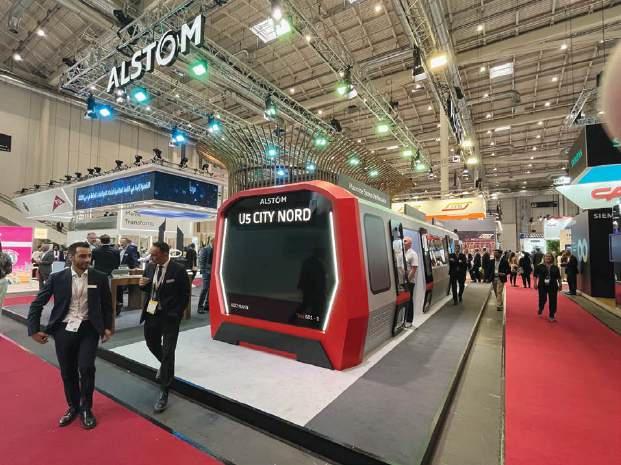
weekday trips, half of which are made on the metro. Santiago is undergoing major expansion, aiming to grow its network to 11 lines by 2034.
Leading smart and sustainable mobility manufacturer Alstom demonstrated its commitment to Hamburg, where up to 374 new fully and semi-automated metro trains will come to the city for metro line U5, a fully automated and driverless operation with 90-second interval services. The contract signed with Hamburger Hochbahn in July 2024 is worth up to EUR2.8 billion.
Alstom will also equip the 25km (16-mile) U5 with the innovative traincentric CBTC system Urbalis. The first call-off comprises 48 metro trains and the CBTC equipment for the first section of the route, including five of the 23 new metro stations. The secondary contract is worth around EUR670 million.
Alstom also showed its new flip-up seat for metro vehicles, and new-style lighting. Other manufacturers showing off their latest vehicles and technology included Hitachi Rail, Tatra-Yug, CRRC, CAF and Siemens. Four exhibition halls showcased new products and services, new technologies and integration, promoting sustainability and innovation throughout.
The opening panel on the third day highlighted again how fragmented some Latin American countries are. Some cities have excellent infrastructure at their centres, but not elsewhere. Funding is a continual issue to make all areas safer and more efficient. For example, cities in Columbia have frameworks and subsidies that rely heavily on local government. There are issues with health, housing, education and transport, but the lack of regulatory frameworks makes it easy to do nothing. The consensus is that governments need
to be stronger and to fully integrate metro and bus rapid transit lines.
In Madrid, Spain, national and local authorities come together to integrate their transport infrastructure, and a regulatory framework ensures that all stakeholders are involved in technology integration.
The perception and culture of harmonious working across Mexico was also raised, looking at how institutional frameworks have limited vision. Political change roughly every three years means that little ever gets done. Change is needed, with financial institutions giving more input to achieve change.
Automation of trams and buses is an area of growing interest, with the potential to enhance efficiency, safety, and sustainability. Technologies that can help are automated driving systems (ADS) for buses, depots and potentially transport corridors. A panel was moderated by Ana Moreno, CEO of Tranvias de Zaragoza (Spain) with Ali Ihsan Danisman from Adastec, Paolo Ghezzi (Busitalia) and Javier Goikoetxea (CAF). It highlighted how operators and industry stakeholders are looking to manage the expectations and practical use cases of automated operations. The tramway in Oslo (Norway) is going this way, and testing of autonomous driving of buses is taking place in Groningen, Holland.
Cable cars as a realistic solution for urban transport was an interesting topic that attracted a large audience to listen to Marie Cluet from Systra, with Dominik Berndt from Cable Car World, Tomas Andres Elejalde Escobar from Metro de Medellin and Lei Wei from the cable car branch of Chongqing Public Transport Operation. The panellists highlighted the potential to improve connectivity, alleviate congestion, bridge gaps in mobility, and extend existing transport systems. They all shared their insights into the opportunities, challenges,


and prospects of integrating cable cars into overall strategies.
Project ideas were discussed, with examples in Germany from the Ruhr Metropolis, a large area. Another example was Brest in France where integration between cable cars and other public transport is being looked at. Medellín in Columbia is also considering cable cars to grow the already 3.8 million annual ridership. A one-ticket system with a 90-minute expiry time can be used on any public transport in the city.
Mobility 5.0, which examines emerging trends and opportunities in public transport, was another popular session, looking at the next generation of smart, seamless, and sustainable urban mobility. Authorities and operators came together to talk about how cutting edge trends, innovative technology, and policy shifts are shaping the future.
Representatives from Modaxo, ARUP, Tower Transit Singapore, CAF Bank of Latin America and SMRT Trains discussed ‘people’ and not just passengers as the important link here.
Artificial Intelligence was included in the discussion, with software vendors able to deliver more value faster with cheaper and smarter solutions. A call for collective leadership was made to rebalance procurement and collective responsibility, again putting people first.
UITP President Renée Amilcar has been unanimously re-elected for a second term until 2027, while Gautier Brodeo of France’s RATP Group, France, is her deputy.
UITP will soon be unveiling a major new initiative to celebrate public transport. The campaign will put the global spotlight on the essential role that public transport plays in daily life, economic vitality, and climate action.
In a landscape where transport decisions are often handed down from above, Pre Metro is pursuing a different path: rooted in dialogue, collaboration, and local ambition.
Over the past six months, we’ve committed to building consensus across the West Midlands to ensure our proposals, including the Dudley Dasher, respond directly to the needs of the people they’re designed to serve.
Our journey began with a clear priority: local engagement. In January, we welcomed West Midlands Mayor Richard Parker and Stourbridge MP Cat Eccles aboard the Stourbridge Shuttle – our flagship Very Light Rail (VLR) service, a benchmark for reliable, cost-effective, and low-carbon transport.
The conversation evolved from statistics to strategy: how could the Shuttle’s success be replicated to deliver better public transport connections across the Black Country?
That idea took form in the Dudley Dasher, a pragmatic and affordable proposal to reconnect Stourbridge, Brierley Hill, and Dudley using existing rail corridors and future Metro links.
In May, Dudley MP Sonia Kumar became the latest in a growing list of civic leaders,
councillors and business owners to visit our team and learn how this scheme could meet long-standing regional challenges head-on. These visits aren’t symbolic. They shape our strategy. Stakeholder input has informed the Dasher’s feasibility in prioritising accessibility and reaffirming our focus on modal shift and cost-effective delivery.
Also, over 1000 residents and 300 businesses engaged with our previous surveys. The message was clear: they want a direct, reliable, and sustainable link between Stourbridge and Brierley Hill.
At an estimated GBP30m (EUR34.9m) capital cost, the Dasher will unlock access to key services: education, healthcare, retail, and leisure, all while helping cut the region’s overwhelming dependence on car travel (currently over 80% in Dudley).
It will also be powered by the next generation of zero-emission, UK-built VLR vehicles, designed for both environmental performance and long-term efficiency.
This isn’t a theory. Our proof-of-concept, the Stourbridge Shuttle, has become a local icon, carrying more than 500 000 passengers in 2024-25, operating with 99%
reliability and at less than half the cost of conventional heavy rail. It’s a quiet but powerful demonstration that rail can be both affordable and dependable. We don’t need to reinvent the wheel; we just need to scale what already works.
And that’s exactly what the Dudley Dasher represents: a scaled-up, smarter version of the Shuttle that can deliver rapid benefits across the Black Country. It’s a rail link designed by and for the region, delivered on existing infrastructure, using homegrown supply chains, and aligning with the government’s goals for net-zero transport, levelling up, and reactivating underused branch lines.
Momentum continues to build, and our commitment hasn’t wavered. The Dasher is a practical solution to real problemscongestion, poor access to jobs, and escalating railway costs. We’ve laid the groundwork. We’ve built the partnerships. We’ve proven the concept. Now, we need action.
With continued support from councils, MPs, local businesses, and national policymakers, we can deliver the next great transport success story – designed, built, and backed by the Black Country.

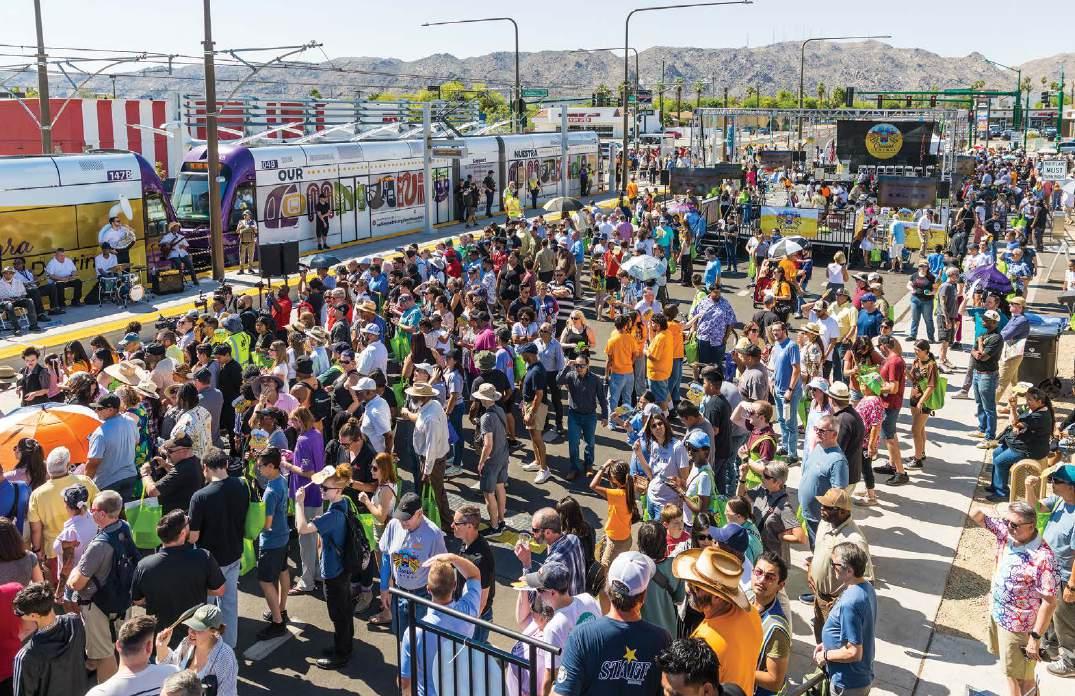
the Valley Metro system in phoenix, arizona, opened its latest extension in June – as andrew Grahl reports.
On Saturday 7 June, the Valley Metro Regional Public Transportation Authority opened a USD1.34bn (EUR1.16bn) light rail extension in Phoenix, Arizona. Called the South Central Extension, the 8.8km (5.5-mile) line is projected to add 8000 daily riders to the newly-expanded 56km (35-mile) system.
Eight new stations were added, seven along Central Avenue, south from downtown Phoenix, across the Salt River to Baseline Road, where a new 110-space park-and-ride facility was constructed. The final station is located at First Avenue & Lincoln Street. The line separates to run bidirectionally; north on Central Avenue and south on First Avenue in Phoenix.
With this expansion, Valley Metro introduces a two-line rail system; the A line, from Phoenix east to Tempe and Mesa, and the B Line, from north Phoenix to south Phoenix. Connections are made between both lines at the Downtown Phoenix Hub station, where four platforms provide transfer opportunities for riders on First Avenue, Central Avenue, Jefferson Street and Washington Street.
Valley Metro riders will now have more frequent service. Weekday service is now every 12 minutes until 19.00, and every 20 minutes thereafter. Saturday service is
every 15 minutes until 19.00, and every 20 minutes after that. Sunday has 20-minute service all day. A weekday trip from the downtown Hub to the Baseline terminal is scheduled to take 19 minutes.
“We built this project with the community to achieve their vision, and we will continue to advance the community’s vision to connect the West and East valleys.”
Fourteen Siemens S700 light rail vehicles were purchased in 2020 for this extension. They supplement 11 S700 cars ordered earlier and the original order of 50 Kinki Sharyo cars built for the start of light rail service in 2008. Six Brookville Liberty streetcars are also operated by Valley Metro for service on the Tempe Streetcar. Convenient transfers exist between light rail and the streetcar in Tempe.
Passengers with a single ride ticket can transfer between lines for no additional
charge during a two-hour fare window. An adult ticket costs USD2 (EUR1.73), while a day pass costs only USD4 (EUR3.45).
Festivities for the opening ceremony were held at three locations along the line from 8.00 to 12.00: Baseline Road/Central Avenue, Ed Pastor Transit Center, and the Downtown Hub. A ribbon-cutting ceremony was held at Baseline Road/Central Avenue. More than 5000 people attended the celebrations.
Valley Metro CEO, Jessica Mefford-Miller, said: “Today we are celebrating 5.5 new rail miles and the transformation of Valley Metro Rail into a multi-line operation, creating an important new connection to South Phoenix. We built this project with the community to achieve their vision, and we will continue to advance the community’s vision to connect to the West and East Valleys, and bring greater mobility and economic opportunity to more of metro Phoenix. I congratulate and thank the community and our teams for today’s successful opening!”
“This historic extension introduces the region’s first two-line rail system, creates safer streets and new bike lanes and adds shade and public art — all while connecting more residents to jobs, education, entertainment and other amenities across the Valley,” said Phoenix Mayor Kate Gallego.
Family activities, local entertainers, fireworks, food vendors and a car show were



part of the celebration. Rail service to the new stations commenced at 09.30.
Unique artwork from 18 artists, 14 of which are local, was added to the new stations. The installations represent the culture and rich local history of south Phoenix.
The South Central Extension created 5000 local jobs, with more than 10% coming from the area served by the new line.
The area was selected for expansion as 44% of local residents have limited or no access to personal vehicles, providing access for historically underserved communities.
Comprehensive utility upgrades were made during construction, replacing more than 48km (30 miles) of infrastructure. Additional improvements include pedestrian pathways and bike lanes. More than 550 trees were added to provide additional shade in a place that could certainly use it.
Funding for the USD1.34bn (EUR1.16bn) project was provided by federal grants, Phoenix Transportation 2050 and Proposition 400 – the last two being voterapproved taxes to fund transportation. A grant from the Federal Transit
“The project employed over 5000 local people, with workers providing 470 000 hours on the project.”
Administration for USD530m (EUR457.7m) was signed in 2021, covering nearly half the cost of the project.
Project planning on the extension began in 2012. Environmental approval from the FTA came in early 2017, leading to the start of design work. Plans to reduce lanes of traffic on Central Avenue for the light rail construction and later service was met with resistance from local residents. A ballot measure advanced to stop light rail funding failed, leading to the start of construction by contractor Kiewet in 2019. Valley Metro prioritised using locally-owned businesses along the route. USD1.6m (EUR1.4m) was provided in grants to 270 recipients through the Small Business Financial Assistance Program.
According to a Valley Metro news release, the project employed over 5000 local people, with workers from south Phoenix providing 470 000 work hours on the project.
Light rail began in Phoenix with the initial 32km (20-mile) segment to Mesa on 27 December, 2008. Extensions in 2016, 2019, 2024, and now with the opening of the South Central Extension, have expanded the system to 48 stations.
Since its opening, Valley Metro has attracted more than USD17.5bn (EUR15.1bn) in public and private investment development.
Future expansions are planned for the Capitol in West Phoenix and continuing west to the Desert Sky Mall.
The future of light rail and electric traction is very bright in Phoenix.
Come and ride the newest light rail extension in North America!
BeLOW: although plans were initially made for a light rail/ light metro system in shenzhen, these were quickly revised in favour of a heavy metro system, which opened in 2004. Pictured is line 3 at Caopu station in the Luohu District. All images by Howard Pulling unless otherwise stated.

In part two of his review of the inexorable expansion of urban transit in China, Hans-Ulrich Riedel looks at systems in the prospering Pearl River Delta in the south.
Apopulation of almost 75 million – and fast growing –makes the Pearl River Delta in Southern China one of the world’s most urbanised regions, with industrial might and wealth to match. Hong Kong, Shenzhen and Guangzhou, Foshan, Dongguan, Huizhou Macao are collectively known as the ‘Factory of the World’, exporting manufactured products via the nearby South China Sea. Good quality public transport is essential for its workforce to both function and prosper. Compared with other nations, the rate of fixed track expansion in China is eye-watering, but it is nevertheless carefully controlled by bodies such as the National Development and Reform Commission (NDRC).
This article is a review of recent progress, and possible plans for the future.
The city once known as Canton began metro construction in the final month of 1993,
opening its first 5km (three-mile) section of line 1 in June 1997, the fourth city in China to do so.
The network has enjoyed continuous growth ever since. Hosting the Asian Games in November 2010 meant a big push forward to expand it to 205km (127 miles) with seven lines. It is now 679km (422 miles), and there were 16 lines by the end of last year, including the section of the Guangfu line within the Guangzhou city limit.
In the first Development Plan for the Pearl River Delta Region (2008-20), the Guangzhou Metro was planned to reach 677km (421 miles) by 2020, which has only just now been achieved, and some revisions to the strategy have been made over the last decade. It was stated that by the end of the 13. 5-year plan (2020) more than 520km (323 miles) would be in use.
Policies continue to be revised, and the recent Guangzhou Urban Rail Transit Phase III construction plan (2017-23) covers ten projects, including four new lines with a
total length of 258.1km (160.4 miles).
The total investment is CNY219.6bn (EUR26.8bn). It was estimated that Guangzhou would have a rail transit network with 18 lines by 2023, a total of 800km (500 miles), this proved somewhat optimistic.
Supporting the development of Nansha (one of 11 urban districts surrounding Guangzhou) is the biggest highlight of this round of metro planning. Nansha is now connected with lines 18 and 22, and this is the first time that the Guangzhou Metro used the urban express model, with 160km/h (100mph) trains reaching Nansha from Tianhe (around 60km/40 miles, with eight stations) in just 30 minutes. These two lines will be the first to be completed.
A pre-Covid pandemic (2019) overview of the ten projects under the plan showed a significant delay to the expected opening dates of these lines. Of the 258.1km (160.4 miles) expected to open by 2023-24, only 137.6km (85.5 miles) actually did. The rest are following in 2025-26.
guangzhou Plan 2017-23 Opening
Line 3 9.6km 1.11.2024
Line 5 9.7km 28.12.2023
Line 7-II 21.8km 28.12.2023
Line 8 20km 2019-20
Line 10 19.9km 2025-26
Line 12 37.6km 2025-26
Line 13-II 33.6km 2025-26
Line 14-II 11.6km 2025
Line 18 62.5km 28.9.2021 (58.3km)
Line 22 31.8km 31.3.2022 (18.2km)
total 258.1km 137.6km actually opened
During the 14th five-year plan period (2021-25), Guangzhou submitted plans to build nine lines (including extensions of existing routes), totalling 245.7km (152.7 miles). This would include two highspeed metros, two fast-speed metros, and five normal speed metros – although which lines will be implemented will be subject to the urban rail transit construction plan officially submitted for approval.
Line 22 has a design speed of 160km/h (99mph) and is the sister of Metro line 18. The two lines in Panyu and Baiyun are
bi-directional, so, for example, trains from Baiyun Airport can either take line 22 to Fangcun, or use line 18 to Guangzhou East railway station.
The Guangzhou Urban Rail Transit Network Planning Plan (2018-35), approved by the municipal government in November 2020, shows that Guangzhou has planned a total of 53 rail transit lines with a total length of 2029km (1261 miles).
Network planning is divided into three levels: high-speed metros, rapid metro and standard-speed metro. Among them, there are five high-speed metros, 452km (281 miles) in Guangzhou; 11 express metros, 607km (377 miles) in Guangzhou; and 37 standardspeed metros, 970km (603 miles).
The Guangzhou City Land and Space Master Plan (2018-35) includes five urban high-speed lines, while the Guangzhou Rail Transit Line Network Planning (2018-35, hereafter referred to as the New Line Network Planning), includes nine routes: two high-speed metros, two fast-speed metros, and five standard-speed metros. It should be clarified that any lines to be implemented will at the appropriate time be submitted for official approval.
Outside Guangzhou’s city limits, there are connections to its neighbours. Foshan connects to the Guangfo metro line as well as via line 7 and Foshan metro line 2. Dongguan city proposes to link its metro to Guangzhou Metro line 13. Nearby Huizhou city proposes metro connections to Guangzhou Metro. In 2018, Guangzhou was also studying the feasibility of extending line 18 south into Zhongshan and north into Qingyuan.
Directly west of Guangzhou lies Foshan, a fast-growing city with a population of around 9.5 million. It has had big plans for a metro system right from the off, including those to integrate with Guangzhou’s system. Despite several large announcements, progress has been very slow. A plan was presented for eight lines across 264km (164 miles) in 2004. Line 1 (the Guangfo line) leading from Guangzhou was the first to be constructed, opening the first 20.4km (12.7-mile) section in 2010, of which 14.6km (nine miles) lie inside Foshan city limits.
The first Foshan urban rapid rail transit construction plan (2011-18) comprises line 2
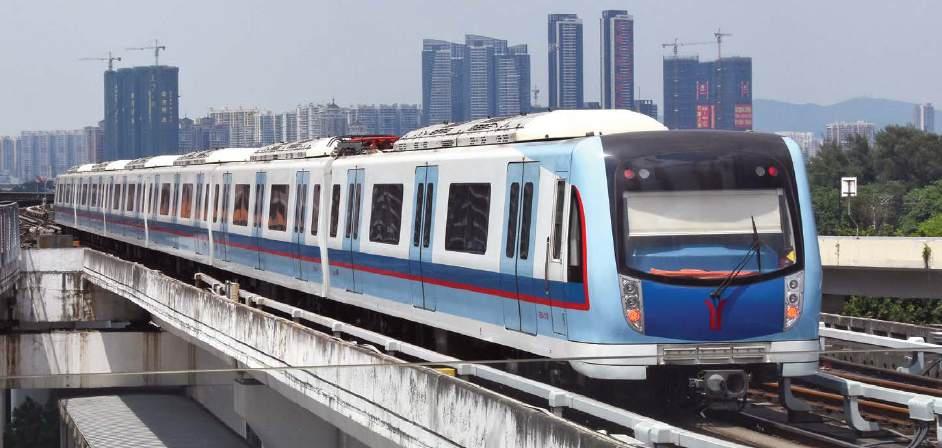

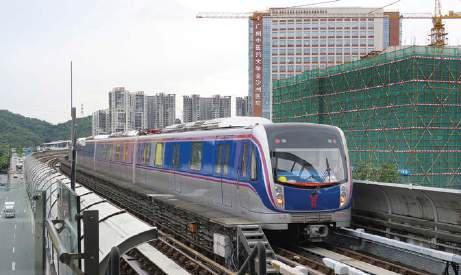
(30.2km/18.7 miles) and line 3 (70.2km/ 43.6 miles), which is the north-south backbone running through the city, a total of 102km (63 miles) and an investment of CNY49.81bn (EUR6.1bn). It was scheduled to open by 2018. Building line 4 was planned to begin in 2015 with opening last year, but work only got under way in 2022. Line 7 heading from Guangzhou was added, with an 11.3km (seven-mile) section in Foshan.
Despite the fact that nothing from the first construction plan has opened, or indeed is expected to do so soon, the city presented its second rail transit construction plan for 2017-22, comprising nine projects. They are extensions to the lines under construction and four new ones, totalling 194km (120.5 miles). They went to the NDRC for approval.
Lines were finally sanctioned under a 2021-26 programme for three projects totalling 115km (71.5 miles), including two new lines (4 and 11). The intention is to have a total network of 252.4km (156.8 miles) by next year, so the city announced a quick start on the construction of three lines for 2021.
It is not going quite to plan however. The only line currently in progress is the missing link of line 3, along with a short southern extension to lines 3 and 4. The system should grow to 11 lines totalling 447km (278 miles) by 2030, but this seems unlikely.
The first independent metro line in Foshan was line 2, opened after much delay in December 2021 over its full length of 32.2km (20 miles); it has 17 stations. It was followed by the inauguration of line 7, which comes from Guangzhou South railway station and runs for 13.8km (8.6 miles), serving eight locations. Around 11.3km (seven miles) and seven stations are located within Foshan.
The important line 3, crossing in a north-south direction through the city, finally opened its first southern section of 40.7km (25.3 miles) with 22 stations in December 2022. The following year saw the commissioning of a 5.8km (3.6-mile) southern extension with four stations; and a northern section of 16.4km (10.2 miles) with nine stations. There is currently a gap in the centre of about 4km (2.5 miles), because changing the location of the new Guangzhou – Zhanjiang HSL railway station requires the demolition and building of a new tunnel section, which should be completed by the end of 2025. Line 3 therefore operates as two isolated sections. In total, this brings the length of the metro to 127.8km (79 miles) in the Foshan City boundary, excluding the tramway.
The long-term development plan for Foshan is for 15 urban lines covering 640km (398 miles), and eight overlapping lines from Guangzhou to Foshan, including 155km (96 miles) in Foshan, a total of 792km (492 miles).
The Nanhai New Transportation system has made more progress with its tramway, which began construction in 2020 and opened as line 1 in August 2021. It is 14.3km (8.9 miles) with 15 stations, and is worked by a fleet of 16 three-section, lowfloor, bi-directional 35.2m trams supplied by CRRC Sifang. Current capacity is 396 passengers, but longer-term plans will extend

the trains to four cars to carry 524 people. The layout appears to be light metro in style.
The city of Dongguan lies east of Guangzhou in a hilly area, and has a population of 10.5 million. Metro construction is proceeding quite slowly, and there are long distances between stations due to the local topography; routes are designated ‘R’ (regional lines).
In 2013, the NDRC approved a construction programme calling for 126.9km (78.8 miles) of rail to be built by 2019 (within six years), requiring an investment of CNY74.8bn (EUR9.16bn).
The first 37.6km (23.4-mile) line with 15 stations opened in May 2016. In the same year, construction of the second line started, with 58km (36 miles) and 25 stations. Although it was scheduled to open in 2022, the date has been revised to December 2025. A 17.3km (10.7-mile) extension to the first line should open in 2027, while a third 51.5km (32-mile) route is still at the planning stage. These three form the basic network, although the city has plans for 14 lines over 476km (296 miles). This also includes light rail, and routes from Guangzhou and Shenzhen for interconnection.
In Huizhou, which sits east of Dongguan and Shenzhen and has a population of around 3.5 million, a separate urban rail project is in the planning stages. The start of construction hinges on resolving financial issues. It is currently connected via one intercity line with Guangzhou, and two new intercity lines from Shenzhen will open in November 2026.
This young city was formed in 1979 by the amalgamation of several smaller communities, and had a population at the time of just 30 000. It was awarded the status of Special Economic Zone because it directly borders Hong Kong.
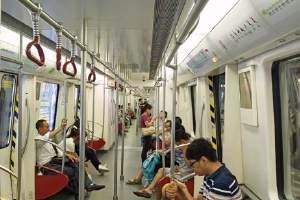
Although large-scale development quickly took off, it was also somewhat restricted by the area’s hilly topography. However, the number of residents grew in 1990-2000 from 1.7 million to seven million, and then to 10.4 million in 2010. The figure currently stands at a very dense 17.6 million, with many tall tower blocks being built in the central area.
Urban rail planning began in 1990, initially for a light rail/light metro, which soon shifted to heavy metro. Construction began in December 1998, and the first 21km (13-mile) section of two lines opened exactly six years later. Several extensions and new lines took the network to 177km (110 miles) by June 2011.
The last decade has not been easy because of several delays caused by rising construction costs, and cuts/reviews being made to approved programmes. Other changes have had to be made because of fastgrowing areas and overloaded services (such as on line 4).
The 2011-16 construction programme approved by the NDRC covers 171.5km (106.6 miles) of lines with a budget of CNY125.6bn (EUR15.6bn). Only a few of these have begun construction, and the revised estimate in 2016 came in at a much higher CNY160bn (EUR19.6bn). Despite all these problems, the next programme for the years 2017-22 called for extensions totalling 274km (170 miles); of which only 149km (92.6 miles) have been approved.
Line 11, the first Express route, opened in 2016, and connects the airport on the

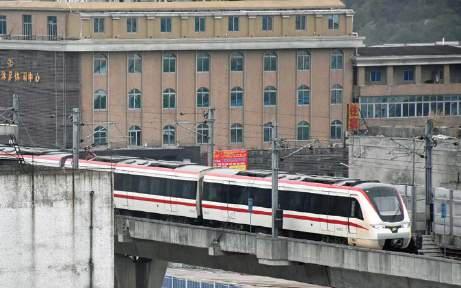
western side of the city by the river to the centrally-sited Futian station. It is 51.7km (32 miles) long, with 17 stations. At its opening, it was the longest and fastest metro line in China, with an operating speed of 65km/h (40mph) and a top speed of 120km/h (74mph). Futian station also serves the Hong Kong – Guangzhou intercity line.
For Line 8, an alternative system such as maglev was investigated as a possible way to reduce costs, but it was finally built as heavy metro. By 2020, the system’s length had reached 411.6km (255.8 miles) across 11 lines, and at the end of last year had grown to 16 lines over 586.9km (364.7 miles).
There is a feeder tramway in Longhua, a northern suburb.
The Shenzhen system is in the fifth construction phase, running from 2023-28, and covers 196km (122 miles). The planned network will reach 831km (516.4 miles) by 2028. Long-term plans under the Shenzhen Rail Transit Network Plan (2016-2035) call for a network of no less than 1142km (710 miles) and 32 lines.
Planned to open in November 2026 are three new intercity lines totalling 169km (105 miles), starting from Longhua (north Shenzhen), with one to Huizhou and another to Dalian.
In addition to the sections located within the city, Shenzhen has discussed
joint plans with neighbouring cities to extend its metro network outwards and connect its metro to other cities’ networks. However, none of these plans are currently active.
The Dongguan Urban Rail Transit, II Phase Construction Plan Adjustment (2022-30) is worth examining, because it goes beyond the addition to the Dongguan section of the northern extensions of Shenzhen lines 6 branch line and line 11, the eastern extension of Shenzhen line 10, and (going further north) line 20. The remaining routes are not yet included in the plan, and there is no clear timetable.
Hong Kong has a special role in the region. Some important communication connections have opened up over the past decade, including the East Kowloon and South Island Line, and most recently in May 2022, the East Kowloon line that runs under the harbour. This is the fourth harbour crossing, and passengers from the northern Territories can travel directly to HK Island without using the intersection at Kowloon Tong.
The total network has expanded to 209km (130 miles), and some smaller extensions could still be realised – a number have already been designed in detail.

The opening of the XRL intercity line from Kowloon to South Guangzhou (formerly known as Shibi) in 2018 was significant, from which high-speed trains travel to Beijing; the travel time from Kowloon to Guangzhou south is only 46 minutes. In Shenzhen, there are two stations: Futian and Longhua, and another in Dongguan Humen.
The Hong Kong – Zuhai – Macao land bridge, which opened in November 2017, is also key for traffic crossing the Pearl River Delta. A new road including an underwater tunnel section from Hong Kong Airport Chek Lap Kok to Tuen Mun (opened in 2020), connects further north to the existing Shenzhen Baybridge. A rail connection from Shenzhen to Zuhai over the bay is also planned, as well as to Hong Kong’s airport.
On the opposite side of the bay, there are separate urban rail plans in Shunde (south of Foshan), Zhongshan and Jiangmen, but construction has yet to start.
Other plans exist for Zuhai and Macau Macau has a U-shaped light people-mover with two short branches, utilising rubbertyred cars. Zuhai’s tram line is currently suspended, and there are plans for a metro-style urban rail system.
An express railway network is viewed as essential in this region due to the large areas to be covered and long travel times: the Pearl River Delta Intercity network. Under this umbrella are some metro lines that are listed under neighbouring cities, such as the Guangfo line connecting Guangzhou with Foshan. The basic concept is a circular route around Guangzhou/Foshan, including a northern connection to the Baiyun Airport, an eastern half circle, and several radial lines that include connections between, and a bay crossing from Shenzhen to the Zuhai area.
On 30 July 2020, the NDRC approved the Guangdong – Hong Kong – Macau Greater Bay Area (Intercity) Railway Construction Plan By this year it was intended that the Greater Bay Area railway network in operation and under construction would reach 4700km (2920 miles) – but this has not yet been realised. It was intended to cover the district’s central cities, node cities, and key metropolitan areas such as Guangzhou and Shenzhen, but delivery could still be some
way off. Longer-term, the network should reach 5700km (3542 miles) by 2035, covering all the cities above the county level.
According to statistics, the nine cities and two districts of the Bay Area have a total of 11 new high-speed and 13 intercity railways planned (not including those under construction).
The draft Guangdong–Hong Kong–Macau Greater Bay Area (Intercity) Railway Construction Projects document reveals 13 potential new railways in the Bay Area in the near future (excluding the Guangzhou –Foshan River Pearl Intercity and Zhaoshun South Intercity), totalling 1532km (952 miles). The total investment is CNY413.3bn (EUR50.6bn).
Among them, the cost of the Guangzhan high-speed rail alone will be at least CNY76.2bn (EUR9.33bn). This 350km/h (217.5mph) high-speed railway runs 126km (78 miles) from Shenshan (Qianhai-Shantou), 410km (255 miles) from Guangzhan, 136km (84.5 miles) from Shenjiang, 182km (113 miles) from Guanghe, and 193km (120 miles) from Guangzhong–Zhuhai and Macau. In summary, this is three routes from Guangzhou, and two from Shenzhen.
The intercity railway runs 63km (39 miles) from Zhongnanhu Intercity Zhongshan –Tangxia (the Nansha branch of Ganshen high-speed), and 122km (75.8 miles) from Xili to Huicheng South from the Shenzhen –Huizhou intercity.
The first section of this intercity type was the Guangzhou – Zuhai line on the west side of the bay area, 151km (93.8 miles) and 16 stations, which opened in 2011. Since then, some isolated sections have entered service as they have been easier to build.
Guangzhou Metro took over the Pearl River Delta intercity railway plan lines from 2019. These will be operated by a consortium of China Railway Guangzhou Bureau Group, Guangdong Intercity Railway Operation, and Guangzhou Metro Group.
On 12 December 2019, Guangzhou city and Zhuhai city formally signed the Cooperation Framework Agreement of Guangzhou Municipal People’s Government and Zhuhai Municipal People’s Government on Jointly Promoting the Planning and Construction of Guangzhou-Zhuhai Rail Transit
The former Guangzhou metro line 18 southern extension is now part of the Nansha – Zhuhai Intercity route.
On 21 April 2020, Zhuhai and Zhongshan consulted on the Guangzhou Metro line 18 Zhongshan and Zhuhai extension programmes, both promoting transport infrastructure interoperability and reaching a preliminary consensus on cooperation.
A huge step forward was the opening of the Guangzhou south ring and eastern line on 26 May 2024. This connects four services along a 258km (160-mile) east-west axis between Zhaoqing in the west, through Foshan, Guangzhou (GZ), and Dongguan to Huizhou in the east. The new section in southern Guangzhou uses two sections, one of the GZ-IC Ring, and one of the east link line. The goal is a one-hour travel time between the larger cities in the Pearl River Delta.
The next big step will be the opening of the 119km (74-mile) Guangzhou – Zhanjiang high-speed railway in 2025-26, which

will ease the connection between the two sides of the bay and avoid the need to go through Guangzhou South station. This includes a 13.7km (8.5-mile) Pearl River Estuary tunnel, passing under the river at a depth of up to 106m, another record in China. Construction commenced in 2020. The main hub in southern Guangzhou will be Nansha Railway Station, which is due to open in 2028 with up to 14 platforms and 29 tracks.
By 2027, several sections of the planned intercity/high-speed network in the Pearl River Delta area will open and shorten travel times between areas, making for easier journeys and providing relief to existing large stations such as Guangzhou South.
Guangzhou Baiyun, a new ‘super station’
that opened in December 2023, is one of the largest integrated hubs in Asia, designed to support interchange between these routes and metro line 9 (maps of cities that will be connected via the intercity network are easily found on the internet).
In Shenzhen, there are currently two main intersection stations for intercity/high-speed service: Futian in the centre, and Shenzhen North. Several more are under development or are planned across the city, and a new western station will open next year.
For a map of the metro systems of the Pearl River Delta region, visit: https://www.reddit.com/r/transit/comments/ mqlkis/a_rail_transit_map_of_the_pearl_river_ delta_an/
Iain Anderson, Colas Rail’s Managing Director, talks to TAUT about the benefits of an alliance, and what this has meant for the delivery of light rail in the UK’s West Midlands.
ow is Colas involved with the MMA and how long have you been part of it?
Colas Rail is one of the three primary partners for the Midland Metro Alliance (MMA) – the others being the client, Transport for West Midlands, and the design JV led by Egis Rail. Colas Rail is responsible for the project management and delivery of all aspects of the schemes, including building and civils, highways, track, rail systems, power and overhead, and urban realm enhancements.
The Alliance was formed in July 2016, and as the first Alliance Director I have been involved since the very start. For the majority of this period my role has been as the Colas Rail representative on the Alliance Leadership Team (ALT). The ALT is essentially the strategic board of directors for the Alliance, made up of three individuals –each being the senior representative of each of the three primary partners.
Key decisions, with recommendations, are brought to the ALT by the Alliance Director following debate within the Alliance Management Team (AMT) – this body fulfilling the role of Operations Board for the Alliance.
All decisions at ALT are required to be unanimous to ensure that decisions are made on a ‘best for programme’ basis and that two parties cannot ‘gang-up’ on the third to force an unpopular decision through. This approach works well as it demands justification and understanding of the reasoning behind any proposal before it is adopted, and it encourages the three ALT members to act in a collaborative and balanced manner.
Transport for the West Midlands (TfWM) is a primary employer for the West Midlands; and the Alliance has been able to deliver, in parallel, a comprehensive programme of social value projects including: an award winning schools and college outreach programme, the development of the first Light Rail NVQ, supporting local charities, and addressing the skills gap by promoting, employing and developing young talent through our Apprenticeship and Graduate schemes.
Overall, an Alliance is a collaborative agreement between the organisations, to work together, supporting each other, with the wellbeing of the programme as the focus. We have a shared Vision, Values and a Charter identifying acceptable behaviours – along with an Annual Business Plan outlining short-, mediumand long-term objectives.
Iain Anderson, Managing Director. Colas Rail

“This longevity brings an ability to make decisions on a more informed and longer-term basis.”
Firstly, an Alliance differs from traditional procurement as it is a longterm programme level, multi-scheme arrangement, rather than a one-off project procurement exercise. The primary advantage of an Alliance, over all other contract types, is the ‘best for programme’ approach. It enables all three organisations to come together as one, bringing the best people and processes aligned to a set of common goals and objectives. One other key difference is you will see we all work under the banner of MMA, and not our individual company branding. This fosters and supports that ‘one company’ focus.
In the case of the MMA, the Alliance has an initial period of ten years for the awarding of a bank of works, and this will extend as we can already see the delivery of the latter schemes that are currently in the process of award will mean we remain engaged in this programme until at least 2030.
This longevity brings an ability to make decisions on a more informed and longer-term basis. It has brought benefits to the supply chain as we have been able to establish long-term strategic frameworks, and we have been able to help support the growth and development of a significant number of local SME organisations.
The commercial risks are owned by all three parties, and although individually managed by the party best placed to do so, the impact is felt across all through a shared budget and risk allocation. The key difference within a three-party Alliance is that it is balanced – with a ‘win-win-win’ or ‘lose-lose-lose’ arrangement, rather than one party bearing all the pain to the benefit of the remaining two.
The formation of the Alliance in 2016 coincided with the appointment of Andy Street as the first Metro Mayor for the West Midlands and the creation of the West Midlands Combined Alliance. Our first challenge was therefore to grow our business whilst delivering for a completely new client organisation that was also starting to find its feet, and establishing its own rules around governance and engagement.
As you would expect, we have made some mistakes and learnt several lessons along the way, but as both organisations have matured we’ve established a platform of management systems that successfully balances the needs of a proactive alliance, concurrently delivering a number of complex infrastructure projects, along with the governance and control required of a large publicly-funded body.
The Metro programme has been delivered at the same time as the West Midlands has seen an enormous increase in construction activity – commercial development across Birmingham, Wolverhampton, Dudley and Coventry, but overlaid by the challenge of HS2 and its enormous draw on resources, labour, plant and materials.
This has meant that engaging and retaining the best talent in the supply chain has been paramount, and again the fact that we have been delivering a long-term framework, seek to be a fair employer, and can act as a sustainable client/employee, has helped us to build strong long-term arrangements with top performing organisations and people.
COVID was a significant challenge, but we were able to see some benefit along with the increased challenges around logistics
and adapting work practices. When the first lockdown was imposed we were working on Broad Street in Birmingham, delivering the Edgbaston extension. This road has a strong commercial and night-time economy, and the original plans severely restricted the length of road section we were able to close at any one time for construction. However, the temporary closure of all public spaces and bars along the route meant we were able to modify our programme and take possession of much larger sections than had originally been anticipated, thereby allowing us to improve outputs and offset some of the additional COVID-related restrictions.
What are the benefits to the region of the extension projects, both now and in the future?
You only need to walk along the routes of the recentlyconstructed extensions to see the impact they are having on the surrounding communities. The simple truth is that the installation of a tramway, particularly one where the client has had the foresight to use this enhancement to raise the quality of the surrounding environment through aligned urban realm and highways initiatives, attracts significant private investment alongside the route.
At the Library stop on the Westside extension we now have the UK HQ of HSBC. In Digbeth alongside Birmingham Eastside, the BBC is currently refurbishing the old tea factory into its new regional headquarters, and Dudley is seeing an explosion of new investment in anticipation of the forthcoming opening of the new Black Country line. This investment not only raises the standard of the environment but also brings jobs and further secondary investment into the region.
Underpinning the design of the new network – and a ‘network’ is what Midland Metro is developing into from just a single line between Birmingham and Wolverhampton – is the principle of a truly integrated transport system.
All of the extensions are designed to interact with other modes of transport, whether it be ensuring that interaction with bicycles is made as safe and seamless as possible, linking with bus depots in Birmingham, Dudley, and Wolverhampton, enhancing a key bus interchange on Moor Street, Queensway, or linking with conventional rail by servicing the West Coast Mainline at both Birmingham and Wolverhampton.
In addition the Birmingham Eastside extension will interchange with the forthcoming High Speed Rail station at Curzon Street. Should the current plans for a further extension to the St Andrews football ground gain approval, it will be a key element in the development and servicing of a ‘sports quarter’ for the city.
How have you responded to the specifics of the geography and environment of the areas the tramway runs through?
Whilst the programme is being delivered under the single banner of the MMA, and the rudimentary basics of a track system are uniform across the programme, the nature of the individual projects themselves varies significantly depending on their geography and purpose.
The Birminghan Eastside and Westside extensions have been completed in ‘live’ highly urbanised city centre locations bringing constant challenges around utility diversions, traffic management, stakeholder engagement and interface with the public. This has meant the degree of interface with powerful external stakeholders has been significant and our teams have had to meticulously plan and programme the works to ensure we minimise disruption – and then ensure we live up to our promises.
On the Eastside extension we have also had to overcome the unique challenge of respectfully removing and relocating almost 500 bodies from an existing burial yard underneath the route.
The challenges on the Black Country line, running from Wednesbury to Brierley Hill, are very different as the route is mainly located on a disused heavy rail freight line. This has brought its own set of challenges as each of the 27 existing structures on the route has required inspection, and either
repair, or in some cases, complete replacement.
This has been completed with an eye to maintaining the heritage of the area and was recently recognised at industry level with an award for the sympathetic replacement of the iconic Hanson bridge in Dudley. The most striking piece of heritage, however, has been the four-year programme of works to ensure the retention of the Brunel-constructed Parkhead Viaduct, where a combination of brickwork repairs, grouting, pinning and reinforced concrete trough has meant the original plan to demolish the structure was superseded, bringing not only heritage benefits but also delivering significant savings in both carbon and financial costs.
Colas Rail is a global leader in rail activities and in particular, light rail schemes.
Colas Rail is currently maintaining, enhancing or extending light rail schemes on every continent (with the exception of Antarctica), and as the UK arm of the business, we can draw on this wealth of knowledge and ability to ensure we are bringing the latest thinking and technology to our clients.
It is this experience that has led Coventry City Council to appoint Colas Rail as its delivery partner on the ongoing Coventry Very Light Rail (CVLR) initiative. Our team, many of whom are also supporting the MMA programme, are very excited to be working on what could be a game-changing initiative for the UK and global light rail industry.
Colas Rail has been established in the UK since the purchase of Amec Spie in 2007 and is consistently one of the top three contractors for Network Rail to whom, alongside our construction activities as part of the Southern Rail Systems Alliance, we provide support through our fleet of engineering trains, tampers and heavy equipment.
The company’s specialism also extends to high speed rail and we have recently been appointed by HS2 to design, supply and install all the overhead catenary system for the forthcoming line.
Our light rail activities in the UK – and globally – extend well beyond the Midland Metro and Coventry City Council in the West Midlands; we have contributed to the development of almost all the networks in the UK. We currently have frameworks with both Manchester Metrolink and Sheffield City Council, and are currently working on the development of schemes on Tramlink for Transport for London, as well as supporting a number of public bodies that are keen to introduce light rail into their own towns and cities.


andrew thompson visits Liège, which inaugurated its first tramline in april this year. It is already proving to be a hit.

toP: car 5112 at the main railway station Liègeguillemins, framed by the sweeping terminal roof and modern architecture of santiago calatrava. the landmark station was inaugurated in 2009. the new tram stop has been elegantly fitted with cobble stones to enhance the urban space. generally the city has used the synergy effect of tramway construction to implement widespread urban beautification and upgrade public places. aside from grass tracks, various other artistic touches have been added, with often just little details making a big difference or adding to the quality of experience for travellers.
After decades of discussions, various planning iterations, numerous construction postponements as well as several rescheduled opening dates, the Belgian city of Liège was finally able to celebrate the inauguration of its modern tramway on 28 April.
Previously the first generation tram network had been in use for almost 100 years, from 1871 to 1968. Historically dependent on heavy industry, Liège has diversified its economy in recent decades, while maintaining its strategic location at a crossroads of major motorways and important international railway lines.
Currently Liège has a population just shy of 200 000, with 600 000 in the wider conurbation. This previously made it one of the larger cities in western Europe without mass transit. Despite 700m of underground track being built in the 1990s along Quai Saint-Léonard and Quai de la Batte, the premetro scheme akin to Charleroi was later abandoned on cost grounds. As urban mobility deteriorated and congestion problems became prevalent,

a modern tramway with largely gradesegregated tracks and low-floor rolling stock was deemed the most cost-effective mobility solution.
In order to get financing off the ground, a public-private partnership model was selected, and in 2017 the ‘Tram’Ardent’ consortium of CAF, Colas and the Dutch fund DIF Infrastructure V was given the nod as preferred bidder. Following completion of the system, the consortium

was granted a 27-year contract for operation of the network. Initially budgeted at EUR380m, final costs for the Liège tramway are expected to come in at EUR430m.
Construction of the 11.7km (7.3-mile) trunk route with two short northern branches commenced in 2018. By October 2023, the first trial runs could have occurred, but the authorisation process and trial running without passengers would prove to last longer than originally expected.

“Liège is the first Belgian city to receive a new tramway since 1901, and other than the capital Brussels, the only one built to standard-gauge. ”
From the southern terminus at Sclessin, conveniently located next to the namesake stadium of football club Standard de Liège, the lone line runs through the industrial estates of Val Benoît before serving the striking main railway station LiègeGuillemins. From there the route continues through the city centre, first serving large parks at Charlemagne, before connecting landmark attractions at Opera and SaintLambert. From there the tracks diverge on a loop. While northbound services run along the banks of the River Meuse on the single-track line via La Batte and Curtius, southbound trams take the more inland path past the two stops Pont Maghin and Feronstrée. The last two shared stops at the northern end of the trunk route are Marengo and Pont Atlas, before the line splits with the eastern spur crossing the river and calling at Droixhe, then terminating at Liège Expo. Meanwhile the northern spur stays on the western bank of the River Meuse and calls at Parc Reine Astrid before ending at Coronmeuse, where new residential and commercial buildings have been built in conjunction with the light rail development. As recently as 2024, both a southern extension to Jemeppe/Seraing and a northern extension to Herstal were planned, but the newly-elected regional government of Wallonia scrapped these schemes on cost grounds in August 2024, in favour of less expensive Bus Rapid Transit (BRT) solutions. The Liège light rail system is standard gauge (1435mm) and designed for LRVs with a width of 2.65m. CAF has supplied 20 seven-section, double-ended 45.5m type Urbos 100 trams with a sleek silver livery.
They offer a total capacity for 310 passengers, with 62 seats. These are numbered 5101 to 5120. Eighteen vehicles are required to operate weekday morning and evening peak periods, thus offering a 4.5-minute headway. The most infrequent timetable interval is 15 minutes, typically reserved for early and late hours or Sundays.
For aesthetic reasons, various sections of the tram route are not fitted with overhead power lines near prominent urban landmarks such as Guillemins station or Opera. The LRVs therefore use battery packs for off-wire operations.
Services are run by the public entity Opérateur de Transport de Wallonie (OTW), which is better known under its brand Transport en Commun (TEC). In addition to the new Liège tramway, TEC also runs the light rail system in Charleroi and buses around the region.
Liège is the first Belgian city to receive a new tramway since 1901, and other than the capital Brussels, it is the only one built to standard-gauge.
As the comparatively short 11.7km (7.3-mile) line mainly serves the city centre and the most adjacent districts, it cannot be deemed sufficient for the city’s mid- to longterm mobility needs and barely alleviates the decades-long lack of rapid transit prior to opening. Even with the previously-planned north and south extensions currently shelved, over the coming years pressure will likely arise to develop the system and make a true network of it with more lines. Just weeks after inauguration, the new service was already proving exceedingly popular and often ran at capacity during off-peak hours. As the platforms at many stops cannot be lengthened, the only immediate way to boost capacity would be to introduce more frequent services and acquire yet more vehicles.
In short, the light rail story in Liège is just getting started.
rIght: between Place ferrer and Petit bourgogne, line t1 passes underneath the historic railway viaduct that carries the electrified main line over the river meuse.
beLoW: Place saintLambert is the busy city centre square where the loop line has its southern starting and ending point. to the right is the northbound single track alignment towards the riverside and La batte; straight ahead is the double track to féronstrée, which is normally used by southbound services, except on sundays when a divergence from La batte is also required for northbound services.
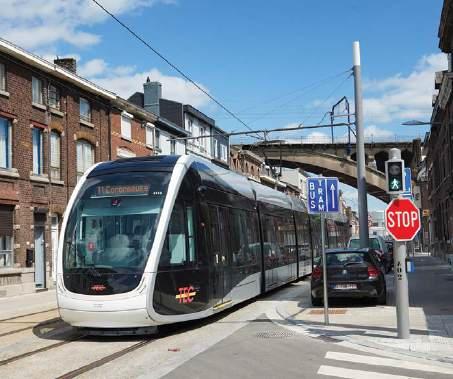


“Over the coming years pressure will likely arise to develop the system and make a true network of it with more lines. ”
Andrew Thompson visits one of just three French cities to have retained and continuously operated its legacy system.

Located 50km (31 miles) southwest of Lyon, Saint-Étienne is the administrative capital of the Loire department and has a population of 173 000, with 376 000 in the wider conurbation. Situated at the foot of Mont Pilat (1432m), the city serves as a gateway to the Massif Central and has historically functioned as an important coal mining hub.
From a transport point of view, Saint-Étienne is significant as it features one of France’s oldest tramways, originally opening in 1881. Together with Marseille and Lille, Saint-Étienne is also just one of three French cities to have retained and continuously operated its original light rail system. This legacy network, which initially ran with steam power and then was electrified in 1907, has
ABOVE: Running on line T2 to the main railway station at Châteaucreux, CAF Urbos 952 is seen passing the grand post office building from 1930.
RIGHT: Calling at Place Carnot, TFS 934 runs northbound with a line T1 service. To the rear is SaintÉtienne Carnot, a modern calling point dating from 1980 that sits atop a historic railway viaduct on the line through the Massif Central to SaintGeorges-d’Aurac.

“this legacy network, which initially ran with steam power, has been a remarkable survivor, while other similar-sized cities around europe lost their original tram systems”.
Parc – Champirol
Lycée S. Weil
Musée d’Art Moderne
Quartier Grouchy
Roger Rocher Allez les Verts
Rue Barra
Chaléassière
Cité du Design
Place Carnot
Grand Gonnet
Place Jean Jaurès
G. Guichard Musée des Verts

Technopôle Christian Cabal
Zénith – Comédie

Peuple Libération
Hôtel de Ville
Peuple Foy
Moulin
Peuple Gambetta
Saint-Louis Bourse du Travail
been a remarkable survivor, while other similar-sized cities around France and Europe lost their original tram systems in the mid-20th Century. Additionally, Saint-Étienne boasts one of only four trolleybus networks in France, which is designed to complement the tramway and currently consists of the two lines M3 and M7, with the introduction of more routes planned.
The city’s compact tram system is formed of the three lines T1, T2 and T3, with T1 being the main northsouth trunk route via the centre, while T2 and T3 link up the main railway station Châteaucreux and provide connectivity either north or south. The newest part of the network is actually the alignment of line T3 from Châteaucreux via Technopôle to the junction Roger Rocher. Completing an eastern loop, the latest route serves residential districts, light industrial estates, and culture, leisure and sports facilities in the form of the event hall Zénith, the Stade Geoffroy Guichard of local football club AS Saint-Étienne and the Musée des Verts. This 4.2km (2.6-mile) extension opened in mid November 2019.
As such, the Saint-Étienne network currently has a size of 16km (9.9 miles) with 41 stops. This includes the single-track circuit just south of the city centre at Bourse du Travail for southbound services and SaintLouis for northbound trams. While at the northern trunk line terminus

ABOVE: Running on the most recent extension, which opened in mid-November 2019, TFS 916 leaves Zénith-Comedie with the namesake Zénith event hall to the rear.
Post-war, fixed-frame PCC cars were first introduced in Saint-Étienne in the late 1950s, with five articulated PCCs being delivered by the Belgian producer La Brugeoise et Nivelles (BN) in the late 1960s.
These remained in regular service until 1998, when the catenary was adapted for use by pantographs instead of trolley poles. Though no longer in use for those technical reasons, some of them have been preserved for posterity and are on display at the transport museum.
The first generation of lowfloor cars were the distinctive metre-gauge variants of type TFS (Tramway français standard ) produced by the consortium of Alsthom, Vevey and Duewag. These were derived from type Be 4/6 and Be 4/8 partial low-floor cars which Vevey and Duewag had developed for the Swiss cities of Geneva (Genève) and Bern in the 1980s. A first series of 15 single-ended, partially lowfloor metre-gauge TFS were delivered to Saint-Étienne in 1991-92 and numbered 901-
915. These still used trolley poles, just like the high-floor PCCs that were still in use at that time. In 1998 a second series of another 20 TFS was supplied and classified as 916935. These LRVs were fitted with single-arm pantographs from the beginning, while the original series from the early 1990s was retrofitted.
As a technical peculiarity and because of the earlier placement of the trolley poles, all metre-gauge TFS in SaintÉtienne have their pantograph fitted to the rear rather than the front of the vehicle.
The newest trams in the city are the 16 type Urbos 3, which were supplied by the Spanish manufacturer CAF in 2016-17. These doubleended, fully low-floor cars are 33m long and consist of five modules. They are numbered 941-956 and feature dynamic body styling created by the Lyon-based studio Avant première. As the Urbos 3 are almost ten metres longer than the TFS, they also offer roughly 30% greater passenger capacity.
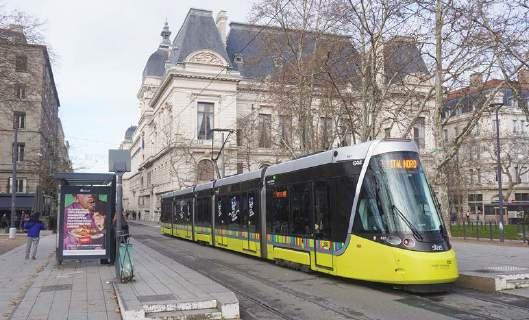
Running northbound on line T1, Urbos 947 calls at Place Jean Jaurès in the city centre, which is framed by the stately Préfecture de la Loire building from 1902.
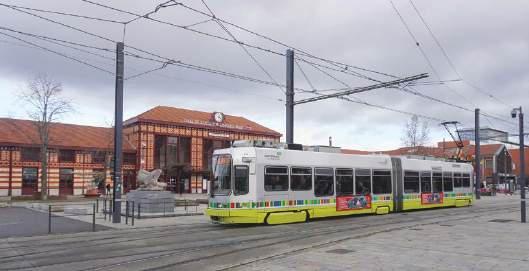


BELOW: Draped in advertising vinyls, Urbos 946 arrives at Châteaucreux with a T2 service to Cité du design.
Opened: 1881 (electric from 1907) l ines: Three (daytime) Depot: 1
Gauge: 1000mm
Power supply: 600V dc s ize: 16km (9.9 miles)
General frequency: Every six minutes peak, or every 20 minutes during early and late hours municipal operator: Société de transport de l'agglomération stéphanoise (STAS) www.reseau-stas.fr c ivic information: https://www.saint-etienne.fr/ tourist information: www.saint-etienne-hors-cadre.fr trolleybus operation: Since 1942, one of just four networks in France. Lines M3 and M7.
LEFT: Along Avenue de la Liberation the tramway and trolleybus network run side-by-side for a section; Solaris Trollino 149 is seen here with an M3 service.
Hôpital Nord a large medical centre is served, at the southern end of line T1 at Solaure there is a large residential district and the trams turn on a wide loop spanning several buildings. Aside from the main station Châteaucreux, the tram system links up with suburban rail and the SNCF main line network at three other points for optimal interchange, including at Saint-Étienne Bellevue in the south, at Saint-Étienne Carnot in the centre, and at Saint-Étienne La Terrasse in the north. The main interchange point between the tramway and the trolleybus system, which first opened during World War Two in 1942, is at the southern T3 terminus Bellevue as well as Hôtel de Ville near the city hall. Thanks to the delivery of 23 low-floor Solaris Trollino in their 12m fixed-frame version from 2019-21, the trolleybus fleet is modern and up-to-date.
Generally Saint-Étienne’s public transport system, which is operated by the Transdev subsidiary Société de transport de l’agglomération stéphanoise (STAS), is tailored to the city’s need and currently there are no extension plans for the tramway. On average, STAS tram and bus services in Saint-Étienne carry 46 million passengers per year.
Since 1993 the Musée des transports urbains de Saint-Étienne et sa région has celebrated the region’s transport heritage and boasts a collection of old trams and buses from the city’s rich mobility history. Among the most celebrated showpieces are an original steam engine from 1881, an electric car from 1907 and a post-war PCC from 1958. The transport museum can be reached by tram lines T1 and T3 at Parc –Champirol, right next to the main tram depot of STAS.
“thanks to the delivery of 23 low-floor solaris Trollino in their 12m fixed-frame version from 2019-21, the trolleybus fleet is modern and up-to-date”.
BELOW: Running southbound on line
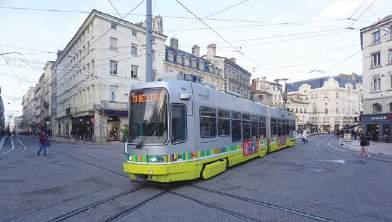
ABOVE: Running southbound with a line T3 service to Bellevue, TFS 916 passes the most complex intersection of the entire tramway at Place du Peuple, where all three lines meet and diverge. The junction has a correspondingly intricate interlacing of tracks, but is not quite a grand union junction.
local travel: Although day tickets are not available, a 90-minute ride costs just EUR1.60, with two such tickets giving ample time to cover the compact network end-to-end.
Saint-Étienne is easily reached by train from Lyon, with SNCF TER services generally running every 30 minutes and requiring a journey time of 47 minutes from Lyon Part Dieu to SaintÉtienne Châteaucreux.
What is there to see and do? Saint-Étienne is an ideal day trip from Lyon, and it is possible to comfortably cover the entire tram network and sightsee the main landmarks in the historic city centre in a couple of hours, not least because all of the primary attractions are laid out along tram route T1. The architecture in the city centre is marked by some spacious squares and elegant historical buildings dating from the 19th Century.


In Italy, this growing tram network reached its latest milestone in January, when line T2 was extended to the university. Andrew Thompson reports.
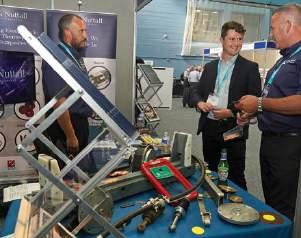
A full round-up of innovation, technology and networking, plus a huge amount of optimism for the UK, from this year’s UKLRC, held across two days in Leeds

Known internationally for the 24-hour car race, Le Mans has a two-line tramway where demand growth is being addressed by lengthening all of the fleet.
+ Washington, US: A city update
+ Classics: Gothenburg
+ The latest news and analysis, system and technical development




2025 ISS u E On sale 15 August


ADELAIDE. A bus came off the O-Bahn guided busway at Klemzig on 10 June. Services were suspended for four days to permit recovery of the bus from the embankment. The Advertiser CANBERRA. Developers have been fined under consumer law for claiming that their properties offered ‘a tram to the city in under ten minutes’ despite there being no finalised route or approval for the final stage of the Woden extension. G. Sutherland PERTH. The 17km (11-mile) Thornlie – Cockburn suburban railway opened on 8 June. Building Perth’s first east-west connection involved realigning existing freight-only railways and bringing into use tunnels that had been built for the Mandurah line in 2001 before its route was changed. The 8km (five-mile) inner section of the Armadale Line has reopened after a viaduct replaced level crossings. RGI SYDNEY. During the 23 May14 June Vivid Light festival, trams terminated at Town Hall due to the crowds at Circular Quay. news.com.au
WIEN (Vienna). The last Alstom Flexity delivered in June was 411. At that time, the oldest Lohner tram still operating was 4310; it was used on driver training duties with trailer 1500.
The first World Tramdriver Championship is to take place in Rathausplatz on 13 September. Previously a European-wide competition, it is now open to entries from around the globe. tramwayforum.at
VITEBSK. The first of two new BKM T811 bogie trams (659/660) entered service on 6 June. transphoto.org

Jingkunxijun Tianshui No.3
Middle School – Wulipua and Yangpo East – Tianshui Airport. They have added a further 16.9km (11 miles) to the system, increasing it to 29.8km (19 miles). A further two lines are planned. urbanrail.net
BOGOTÁ. CRRC Changchun began testing the first of 30 six-car metro trains in April. The first train should be shipped to the Colombian capital in September, with the metro due to open in 2028. RGI
ZAGREB. The last line 9 Duro Dakovic TMK201 bogie trams made a farewell run on 15 June. transphoto.org
DS
ANTWERPEN (Antwerp). Lines on Linkeroever will be closed for six months from May 2026 to permit renovation work in the tunnel under the Schelde. Replacement buses will use the road tunnels.
BELO HORIZONTE. CRRC Changchun unveiled the first of 24 new metro trains in June.
DS SALVADOR. The first tracks for the 16.7km (ten-mile) Ilha de São João – Calçada tramway were laid in April. Completion is planned for October 2027. VLT Salvador
HAMILTON. Ontario’s government has issued a Request for Proposals for the civil engineering work on its planned 14km (nine-mile) line. There are reportedly four consortia interested in the CAD3.4bn (EUR2.1bn) project. Mass Transit MISSISSAUGA. Track at the depot junction, laid a year ago, has had to be replaced by contractor Mobilinx. The work will not be finished until July, pushing the opening date for the CAD5.4m (EUR3.4m) Hazel McCallion Line back to 2026. P. Webb QUÉBEC. RATP Dev has been appointed to operate TramCité. The 19km (12-mile) line is to open in 2033. RGI TORONTO. Control of the Eglinton Crosstown light rail line moved from Metrolinx to Toronto Transit Commission in April. Passenger services could start in September. skyscrapercity
GUANGZHOU. The Huangpu Tram was extended by 4.9km (three miles) from Xiangxue metro station to Kaiyuan Road East on 20 June. urbanrail.net MACAU. The automated metro carried 5.37m passengers in 2024 but still requires a government subsidy, equalling 88% of its revenue. skyscrapercity TIANSHUI. A pair of tramway extensions opened on 18 June:
PLZE Ň. A special event at the U Zvonu turning loop took place on 21 June: it marked the last day of operation of the Tatra K3R-NT trams, plus the 70th anniversary of the introduction of the Tatra T1s and 65 years of the T2. Examples of all types were on display. Plze ň’s trams are now all low-floor. M. J. Russell PRAHA (Prague). Škoda 32m 52T trams 9502/03 entered service on line 12 on 20 June. Lines 11 and 13 were rerouted on 16 June to avoid the 20-month projects to connect tracks at Vinohradská and the
upper part of Václavské námě stí. There will be no tram service between I. P. Pavlova metro station and Národní muzeum until March 2027.
EL QAHIRA (Cairo). Alstom delivered the first of line 1’s 55 nine-car air-conditioned metro trains on 22 May. RGI
LE MANS. Partial suspension of services is to take place 21 July18 August to permit work on the tramway extension. This is to open in early 2026. lineoz.net LYON. The different transport operators in the greater Lyon area, covering 262 communes, are to be unified under TCL from 1 September. A new 24-hour ticket will cost EUR6.90 for Zones 1+2 while an all-zone ticket is to cost EUR9.80. skyscrapercity TOULOUSE. Operator Tisséo now accepts payment in digital currencies, claiming to be the first operator in France to do so. Passengers must use an Android phone and the Lyzi app. TP
BERLIN. As line 21’s track in Boxhagener Strasse needs replacing, it is likely to close in December. Services are unlikely to resume until the planned line via Ostkreuz is ready. Winds on 23 June closed the
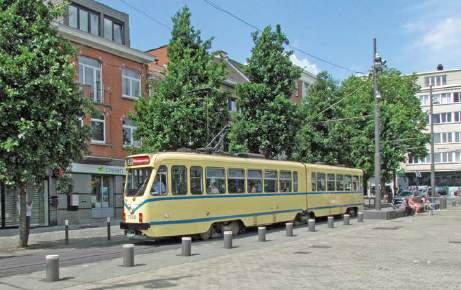
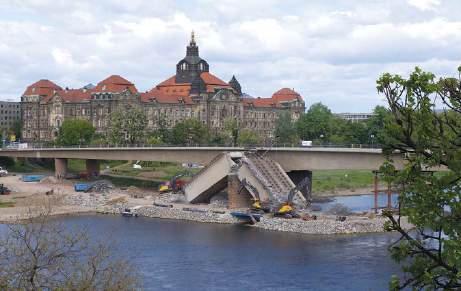
S-Bahn for several hours after trees were blown onto the lines. DS BREMEN. Temporary line 14 was still operating from Huchting to Theater am Leibnizplatz in June. M. Baxter DRESDEN. The tramway crossing at Postplatz was to be renewed from 30 June-21 July, resulting in extensive diversions. DS FRANKFURT/Main. The Europaviertel light rail extension will now reach Am Römerhof, 1.4km (0.9 miles) beyond the originally planned Europa-Allee. skyscrapercity FRANKFURT/Oder. Škoda 46T trams entered regular service from 17 June after a ceremony the previous day. There are eight in service, with three more expected. DS GOTHA. An order was placed with Stadler on 30 May for four double-ended, five-section, 32.5m, 100% low-floor Tramlink vehicles. The contract has an option for a further six. Capacity will be 180 passengers (50 seated). Deliveries should start at the end of 2027. These are to be Gotha’s first new trams since Tatra KT4Ds were delivered in 1982. TWSB HEIDELBERG. New line 21 was introduced from 23 June. It links Bismarckplatz with Hans-ThomaPlatz via Hbf. Replacing line 25, line 21 only runs 06.00-18.00 Monday-Friday. DS KÖLN (Cologne). Refurbished Hannover Class 424 unit was displayed at Nippes DB depot on 1 June to mark 50 years of the S-Bahn. Today, 123 four-car EMUs provide service on five lines. RUHRBAHN. A joint tender with Krefeld and Oberhausen has been issued for four-section 40m cars and three-section 30m cars: Ruhrbahn wants 40 (40m), with an option for ten more plus an option for six 30m versions. Krefeld wants six 30m vehicles, with an option for seven more. Oberhausen wants four (30m) with an option for one
more, plus an option for five 40m vehicles. DS
CHENNAI. Alstom’s Bengaluru plant has won a EUR135m contract to build and maintain 32 standardgauge three-car metro trains. RGI INDORE. The first 5.9km (four miles) of metro opened on 1 June. The elevated Yellow Line is part of a proposed 31.6km (20-mile) 1435mm-gauge circular line. Stations on the Devi Ahilya Bai Holkar Terminal – Veerangana Jhalkari Bai section are not named after geographical locations but prominent Indian women. RGI KANPUR. The 7.3km (five-mile) Blue Line metro extension from Moti Jheel to Kanpur Central opened on 30 May. urbanrail.net
CORK. The team promoting the Cork Luas tram system has described the public consultation process as positive. However, residents in the Blackrock and Ballintemple areas called for more time to review the proposed route.
GREAT LAXEY MINES
RAILWAY. The Three Foot Gauge Society has gifted Manx Electric Railway centre-cab locomotive 23 as well as goods trailer car 26 to the GLMR. MANX ELECTRIC RAILWAY. Trailer car 50 should return to service in July for the first time since 1978. Restoration started in January 2022.
BRESCIA. A Menelli Impresa/ Alstom/Hitachi consortium has won the EUR326m contract to build the 11.3km (seven-mile) T2. The line is to link Fiera to the south of the Italian city with Capolinea Pendolina to the north. The route runs via the city centre and the main railway station. Hitachi
is building 18 five-section LIVe trams, based on its Sirio platform. These will use battery power on 3.1km (1.9 miles) of the line. RGI NAPOLI – SORRENTO (SFSM). Buses are replacing the Circumvesuviana train service between Napoli and Balano until 30 September, while infrastructure work takes place. ERT
HIROSHIMA. Hiroshima Electric Railway’s Ekimae Ohashi line is due to open on 3 August. This will provide an alternative, more direct link for line 5. urbanrail.net
ASTANA. CRRC Tangshan delivered the first 60m foursection LRVs on 11 June. Test running on the 22.4km (14-mile) line is to start in September. transphoto.org
LUXEMBOURG. Construction of the Pfaffenthal-Kirchberg – École Européenne branch started on 16 May. The 2.3km (1.4-mile) line is to open in 2027. RGI
KUALA LUMPUR. The 37.8km (23-mile) automated LRT3 from Bandar Utama to Johan Setia is due to open on 30 September. urbanrail.net
AMSTERDAM. Line 26 is to be cut back to Steigereiland 28 July17 August.
All trams now carry ‘GVBA 125 Jaar’ stickers, marking 125 years of operator GVB. Alstom has been awarded a contract for the mid-life refurbishment of M5 metro sets, built 2012-15. OR ROTTERDAM. Rotterdamse Elektrische Tram carried 162 million passengers in 2024, more
than in 2023, but still 8% below pre-COVID year 2019. A tender is being prepared for 44 new 90m metro trains to replace old stock. Waalhaven workshops will be rebuilt in 2028-30 to accommodate the new vehicles.
OSLO. Correcting our June report (TAUT 1050), SL95s 148/66 were scrapped in May and 151 is the sole survivor; a section will be displayed at the tramway museum. SL79 101 was also scrapped in May. Cars 102 and 140 will be retained in running order by the museum. SL79s 123/126-127/133/137 are likely to be withdrawn in October. A quartet of CAF SL18s – 456/63/8687 – were still in Spain at the end of May. R. Budmiger
KRAKÓW. A tram parade on 21 September is to mark 150 years of local public transport operation. M. J. Russell ŁÓDŹ. PLN27m (EUR6.4m) is to be spent rebuilding the Telefoniczna tram depot, including installing ten new tracks to accommodate 30 trams. The work should be completed in six months. TP POZNA Ń . The six Modertrans Moderus Gamma trams delivered earlier this year were taken out of service from 30 May for work on the braking system. They were back in service on 3 June. cs-dopravak WARSZAWA (Warsaw). The 800m branch from the Wilanów tram line to a new bus interchange at Stegny was brought into use on 28 June. It is served by line 19. TP
MAKATI. Plans for an 8km (five-mile) metro in Makati, part of Metro Manila, have been abandoned after a Supreme Court ruled that some of its stations –and the depot – were no longer in Makati city limits. IRJ

PORTO. The new tram depot/ workshop at Vila d’Este has been completed. P/R SINTRA. Storm Martinho in mid-March damaged the heritage tramway and delayed the reopening for the summer season. There was still no service by 25 June. R. Holliday
ROMANIA
BUCURE Ș TI. The government has approved the purchase of 12 metro trains, initially for line 4. They are expected to cost RON1bn (EUR197m). romania-insider.com
IA ȘI. Tram 2233, the first of 18 Bozankaya 22m three-section lowfloor vehicles, was shown off to the media on 28 May. Skyscrapercity
RUSSIA
MOSKVA (Moscow). The 4.7km (three-mile) monorail loop at Vystavochny Tsentr is to close. Built 20 years ago, its infrastructure is to become a new elevated park. ag.mos,ru SAMARA. Due to the replacement of utilities at the Ulitsa Pervomayskaya/Prospekt Lenina junction, tram services were suspended 13-23 June. transphoto.org
STARY OSKOL. It is reported that the 23.5km (15-mile) express tram line will close at the end of December. The line dates from 1981 and was built to serve the steelworks, which owned it until the city took over in 2003. transphoto.org
YEKATERINBURG. Ust-Katav delivered the prototype 71-665 five-section, low-floor tram to Zapadno depot on 15 June. urbanrail.net
SERBIA
BEOGRAD. Mass political unrest from 9 June, including the setting up of a protest camp at the junction of Kneza Miloša/ Nemanjina, resulted in the
suspension of lines 2L, 5, 6, 7L, 9L, 10, 12 and 14. Just lines 12L and 13 remain in operation until further notice. Both operate from Pogon Sava depot on the west bank of the Sava river. P. Haseldine
SLOVAKIA
BRATISLAVA. The final inspection by the authorities of the Petržalka extension took place on 9-11 June. The shelters at its stops were installed between 14 and 30 June. M. Feik
SPAIN
MADRID. Work has started on the EUR181m line 5 extension to Madrid-Barajas Airport. The 1.7km (one-mile) line is to open in 2028. TP MALAGA – ALGECIRAS. A EUR1m feasibility study has been launched for a possible rapid transit line along the Costa del Sol. RGI ZARAGOZA. All-night weekend tram service started on 27 June. skyscrapercity
SWEDEN
GÖTEBORG (Gothenburg). Tram 379 was damaged and eight people injured in a latenight derailment on Vasagatan on 20 June.
The new branch to Lindholmen is to open when the December timetable change comes into force. It will be served by line 10 and new line 12. gp.se
STOCKHOLM. The European Investment Bank is providing EUR400m to help finance the expansion of the metro, including 30km (19 miles) of new lines and 18 new stations. EIB
SWITZERLAND
BASEL (BLT). The Waldenburgerbahn is to introduce GoA2 automatic train operation this summer. EA BERN. Construction of the Ostermundigen tramway
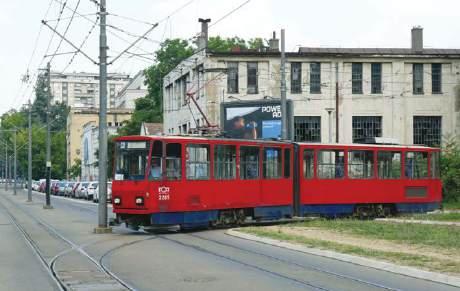
extension will not start until 2027. It will take between four and five years to complete. EA
MARTIGNY – ST-GERVAIS (TMR/SNCF). Of the new Stadler Beh4/8 rack units, 891/93/95 are owned by TMR; SNCF owns 892/94/96-97. EA
MONTRUEX – ROCHERS DE
NAYE (TMVR). Stadler has been awarded a contract to supply eight 40m, three-car panoramic rack trains for the 10.3km (6.4-mile) line. They are to enter service in 2029. RGI
TAINAN. A feasibility study for a 21.3km (13-mile) monorail has been commissioned. Construction could start next year and the route will form the basis of an eight-line network. Part of it could meet the Red Line of Kaohsiung Metro. RGI
BANGKOK. Tenders are being invited for the 8.4km (5.2-mile) Red Line extension from Rangsit to Thammasat University. It could open in 2028.
The Thai and Japanese governments signed a memorandum of co-operation on railway systems and urban development on 30 April. Expansion of Bangkok’s metro is one potential outcome. skyscrapercity
KOCAELI PROVINCE. The under-construction 26.8km (17-mile) metro – due to open in 2028 – is to be extended to reach Istanbul Sabiha Gökçen airport. Skyscrapercity
KYIV. Russian attacks on the city on the night of 5-6 June put the surface section of metro line 1 out of action. Trains trapped on the underground section worked a shuttle service until the
damage was repaired.
Sanok two-axle tram 1892 (built in 1907) has been repaired for tourist duties. transphoto.org
UNITED ARAB EMIRATES
DUBAI. The ground-breaking ceremony for the metro Blue Line took place on 9 June. A Turkish/Chinese consortium is building and equipping the line; it is scheduled to open on 9 September 2029. skyscrapercity
UNITED KINGDOM
BLACKPOOL. The North Station tram stop has recorded over 250 000 passenger journeys in its first year. The GBP22m (EUR26m) extension, which serves the Talbot Gateway development, opened on 12 June 2024.
From 7 July, tickets for Blackpool’s bus and tram networks will be available from train operator Northern.
Blackpool Transport has appointed Steven Staley as its Tramway Operations and Safety Manager. Staley brings experience from Greater Manchester’s Metrolink, Edinburgh’s Newhaven extension and metro systems in the Middle East.
DUDLEY. BCIMO welcomed over 550 visitors to its Family Day at the Very Light Rail National Innovation Centre on 17 May and raised over GBP8000 (EUR9373) for charity.
EDINBURGH. Edinburgh Trams is warning people not to be taken in by a scam that offers six months of free travel for just GBP1 (EUR1.17). The fake cards look like Edinburgh’s Ridacards.
GREATER MANCHESTER. The next phase in Metrolink’s GBP147m (EUR172m) infrastructure upgrade programme is underway. No trams are to run between Piccadilly station and Piccadilly Gardens while life-expired rails are replaced. Altrincham – Bury services will run via Market

Street, as will Eccles – Victoria services. All trams from Ashton and Etihad Campus will terminate at Piccadilly station, while MediaCityUK – Etihad Campus peak time services will not run. Services are to return to normal from 11 August.
Leaders in Bolton are expecting the proposed route for tram-trains into the town to be published within weeks.
INDUSTRY. Light rail operators across the country have been increasing their safety messages as warm weather brings more people to the streets. Edinburgh Trams has reminded cyclists to take care around tramways, while Supertram’s ‘Learn Live’ initiative has reached 6400 young people across Sheffield. Nexus has launched Operation Coastwatch that aims to reduce antisocial behaviour, and Nottingham Express Transit is urging youngsters not to hang on the back of trams in order to make videos for social media.
LONDON (DOCKLANDS).
KeolisAmey Docklands has launched its ‘DLR Innovation Portal’, which provides a platform for staff and stakeholders to share ideas about how the system could be improved.
NOTTINGHAM. A memorial to a cat named Benton, who regularly visited Inham Road tram stop, has been gifted to his owners, the Hicks family. The memorial poster had been at the stop since Benton’s death in 2021.
A reduced four-week MondaySaturday timetable came into effect on 24 June because trams have had to be withdrawn to rectify vandalism and collision damage.
NET is working with police to track down the creators of a ticket retailing website offering fake tickets.
ROTHERHAM. A 289-space park-and-ride facility has opened adjacent to Rotherham Parkgate
tram-train stop. The GBP12.9m (EUR15m) facility also includes electric vehicle charging points and cycle racks.
TYNE & WEAR. Leaking airconditioning units caused four new Class 555 EMUs to be taken out of service in June. This follows the withdrawal of five trains after problems with door operating systems (TAUT 1051).
Station (and an interchange with Line A) to Pioneer Boulevard in Artesia. la.urbanize MEMPHIS, TN. On 10 June the city council said it was hoped to resume heritage tramway operation in the late summer. The trams have been out of service since last August after technical inspection showed deficiencies in the braking system. J. May
NEW YORK, NY. Rockaway peninsula line A and S services resumed on 19 May after reconstruction. Mass Transit NEW YORK – NEW JERSEY.
Port Authority Trans-Hudson (PATH) carried 18.7m passengers in the first four months of 2025, a 7% increase on last year. J. May
SAN FRANCISCO, CA. Bay Area
Rapid Transit’s Link 21 project will be built to 1435mm-gauge. It is to link San Francisco, Oakland and Northern California and will be managed by the Capitol Corridor Joint Powers Authority, with BART staff providing support. Mass Transit
a Chorlton High School modelmaking competition in 1935.
A model tram and railway exhibition is to take place over 16-17 August 2025, featuring up to nine layouts. Normal museum entry charges apply.
HEATON PARK (UK). Infrastructure company VolkerRail has replaced rail and sleepers on Manchester’s Heaton Park Tramway, using rail donated by Transport for Greater Manchester. VolkerRail also rebuilt and resurfaced a level crossing.
NÜRNBERG (DE). Zeppelin bogie tram 144, built by MAN in 1909, returned home on 12 June after its restoration was completed in Kraków. DS
PORTLAND, OR (US). The Willamette Shore Trolley’s season began on 24 May, operating the full line to Bancroft St for the first time since 2019.
Car 513 is undergoing conversion to battery power. Car 514 will be the sole operational tram until 513 is back in action.
S.J. Morgan
AUSTIN, TX. The Austin Transit partnership has released a Request for Qualification for the USD7.1bn (EUR6bn) final design and construction contract for Phase 1 of its planned light rail line.
SEATTLE, WA. The Federal Transit Administration has given the go-ahead, with a Record of Decision, for the 6.6km (4.1-mile) West Seattle Link light rail extension project.
J. May
BETHESDA – NEW CARROLLTON, MD. The Purple Line has awarded USD1m (EUR850 000) in grants to enterprises affected by the construction phase. J. May CHICAGO – SOUTH BEND, IL/IN. The new 11th St station in Michigan City, a milestone on the Double Track Northwest Indiana project, opened on 19 June. The station includes a 542-space park-and-ride building.
South Shore Line DALLAS, TX. Attempts by the Texas legislature to defund Dallas Area Rapid Transit failed after the bill did not progress before the session closure. There may be further legislative action from politicians opposed to funding public transit. J. May DENVER, CO. Alstom has won a USD69m (EUR59m) contract for ten Innovia APM people-mover cars for the airport. RGI LARKSPUR – CLOVERDALE, CA. The Sonoma-Marin Area Rail Transit diesel light rail line was extended to Windsor on 31 May.
J. May
LOS ANGELES, CA. Metro’s board of directors has voted to put the planned Southeast Gateway Line in a 23.2km (14.5-mile) subway from Stauson
Sound Transit moved the first LRV across the I-90 floating bridge over Lake Washington in mid-June, but has not yet given a firm opening date. J. May
MUSEUM NEWS
AMSTERDAM(NL). Celebrations for the 50th anniversary of the museum tram line will be held on 27-28 September, a week later than planned to avoid a clash with the Amsterdam Marathon. OR
BEAMISH (UK) . Former East Brussels steam tram locomotive Lucie visited during June and July. Normally based at the North Yorkshire Moors Railway, the Cockerill 0-4-0VBT was to work Beamish’s colliery railway.
CHELTENHAM (UK). Cheltenham Borough Council is offering the body of tram 21 to anyone who can make better use of it. Withdrawn when the tram system closed in 1930, 21 was restored in the 1960s by a team that included Rolling Stones founder member Brian Jones. It has been in store since 1992. CRICH (UK). Corporate volunteers from Rolls-Royce in Derby have undertaken various jobs around the National Tramway Museum, including repainting iron railings.
The museum has been donated a large-scale model of a Manchester tram, built by Walter Rogerson for
SOUTHAMPTON (UK). Visitors to Solent Sky’s ‘Tram Event 2025’ were able to see Southampton tramcar 11 on its bogies. Restored by Alan Keef Ltd in Ross-on-Wye, 11 is back on rails again for the first time in 75 years.
STADSKANAAL (NL). Ex-War Department Drewry 0-4-0DM WD33 has temporarily moved to Museum Railway STAR. The locomotive, one of five wartime British diesel shunters that worked Dutch tramways between 1946-57, was made homeless following the closure of the Nederlands Transport Museum in Nieuw-Vennep. WOLTERSDORF (DE). Gotha two-axle tram 28 has been sent to the Hannover tramway museum. DS
Worldwide items for inclusion should be sent to Michael Taplin at Flat 8, Roxan Villa, 33 Landguard Manor Rd, Shanklin, Isle of Wight PO37 7HZ, UK. Please fax: +44 (0)1983 862810 or e-mail miketap@mainspring.co.uk UK and Ireland items, please e-mail uknews@lrta.org
Acknowledgements are due to ag.mos,ru, cs-dopravak, Drehscheibe (DS), Eisenbahn Amateur (EA), ERT, International Railway Journal (IRJ), la.urbanize, lineoz.net, Mass Transit, news.com.au, Op de Rails (OR), P/R, Railway Gazette International (RGI), romania-insider.com, South Shore Line, The Advertiser, skyscrapercity, tramwayforum.at, transphoto.org, Transport Publiczny (TP), TWSB, urbanrail.net, and VLT Salvador.
UKtram and the lrssb gear up for the 2025 light rail summit, bringing together sector leaders and technical experts for the sixth year.
Excitement is building across the light rail sector ahead of a major event set to return to Birmingham. Taking place on Thursday 25 September at IET: Birmingham Austin Court, this year’s event is already shaping up to be the biggest yet.
Organised by UKTram in partnership with the Light Rail Safety Standards Board (LRSSB), the 2025 Light Rail Summit will once again bring together sector leaders, policy influencers and technical experts for a day of thought-provoking discussion, collaboration and networking.
Now in its sixth year, the Summit has become a leading event for professionals across the UK light rail sector. Past Summits have been held at venues including St Andrews Stadium (Birmingham, 2018), The Grosvenor Hotel (Edinburgh, 2019), and Greater Manchester Chamber of Commerce (2022). Since 2023, the event has found a home at Austin Court, with its central location, accessible facilities and atmosphere of professional warmth proving popular with delegates.
Following the initial reservation of places for key industry leaders, the remaining spaces were filled just three days after registration opened – an unprecedented response and a clear sign of the event’s growing stature.
With this year’s focus on sustainability, integration, data and social value, James Hammett, Managing Director of UKTram, reflects:
Representatives from Luas Dublin will also present an update from the Irish capital, highlighting cross-border collaboration. Andy Bairstow of Nexus Tyne and Wear will provide an update on their system and progress around integrated smart ticketing.
Additional confirmed speakers include Jake Rudham (Department for Business and Trade), Cat Appleby (Rail Forum), Manu Grundy (International Institute of Obsolescence Management), and Sam Riley of Young Rail Professionals.
Attendees will also hear from the Light Rail Safety and Standards Board, who will provide a key update on ongoing safety programmes and cross-network initiatives. With safety remaining a core priority for all involved in light rail operations, these discussions offer timely insights into standardisation, training and risk reduction strategies being rolled out across the UK.

“The programme reflects the priorities of our members and the challenges our sector is tackling head-on.”
“Every year we build on the success of the previous Summit and 2025 is no exception. The programme reflects the priorities of our members and the challenges our sector is tackling head-on. It’s also an opportunity to share learning and celebrate progress. We’re thrilled to welcome another line-up of fantastic speakers.”
As in previous years, the Summit will open with a welcome from UKTram Chair Stephen Edwards, followed by an update from James Hammett on current initiatives and strategic direction. From there, the agenda moves through a wide range of topics with contributions from both UK and international speakers.
Among those confirmed for 2025 are Rachel Harcourt, Head of Rail Climate Change Adaptation and Resilience at the Department for Transport, who will speak on the importance of building climate resilience into future systems; and Saffron Gurden of Streetlink, who will outline opportunities for the sector to support vulnerable people through awareness and outreach.
In addition to presentations, the Summit offers an opportunity for UKTram members to exhibit their work and services. With a strong focus on peer-to-peer learning, the event encourages a collaborative spirit and features multiple opportunities for informal discussions, including networking breaks and a buffet lunch.
The Summit is also bookended by UKTram’s Functional Working Group meetings, which take place the day before and provide an opportunity for more focused operational and technical conversations within specific workstreams.
“We love putting on this event each year,” says Lorraine George, UKTram Business Manager. “It’s become a real highlight for the sector, and it’s been brilliant to see the way it’s grown. I’m really looking forward to what’s in store this September.’’
All eyes are on Birmingham for what promises to be another landmark event for the UK light rail sector with conversations set to resonate well into 2026 and beyond.
Attendees can look forward to a programme of dynamic presentations and expert sessions exploring how the light rail sector can continue to adapt and innovate in a rapidly changing transport landscape.
In 2005, TAUT covered the private collection of tramcars being assembled by an enterprising individual in the Portuguese capital, Lisboa (Lisbon). Almost 20 years later, we bring this story up-to-date and offer thoughts for the future.
Paulo Marques was disappointed by the lack of representation of various types of older Lisboa (Lisbon) tramcar in the official collection of Carris. The local tramway operator had the intention of establishing a museum in covered areas of its main Santo Amaro depot. But Lisboa had a wide variety of cars, both four-wheel and with bogies, dating from its early years, more especially from the period before the outbreak of World War One in 1914.
Paulo’s aim was to remedy the deficiency and acquire examples that, between the two collections, would fully represent the former Lisboa tramway scene and the changes wrought on the rolling stock over time.
He initially acquired use of a parcel of land south of Lisboa in the ownership of his relatives by marriage. This provided a welcome parking area for his growing collection – but there were serious shortcomings, not least that the building in which the cars were housed was not fully enclosed and so open to the predations of thieves and vandals. Valuable track was lost whilst stored at this site, and several cars that had arrived intact suffered from vandalism, with broken windows and damaged panels. A better solution was needed, and in 2015 a suitable opportunity presented itself.
Land became available around 30km (19 miles) north of Lisboa, beyond the site of today’s airport. The area available was about twice the size of the original plot and it had the great advantage of coming to market on a freehold basis, with fully fenced and locked curtilage. Paulo negotiated its purchase to give his trams a safer home and the cars were all moved there over a period of months.
A building was erected to afford weather protection and was equipped with a modern security and alarm system; more practically the covered area was fitted with five lines of tram track extending beyond the edge of the building into the open land beyond. Of these tracks, four roads were laid to Lisboa gauge (900mm) and one to metre gauge, the latter thereby permitting movement of Paulo’s first acquisition, hilly route car 615. This had been repainted into Sintra-Atlantico red and cream livery and given fleet number 1 to enable it to operate on the Sintra tramway for several seasons. It has not been re-gauged back to 900mm since returning to Lisboa.
There are now 13 tramcars on site, almost all of them owned by Paulo. Of these, eight are classic Lisboa bogie cars built before World
War One, and the fact that these are stored in the southern bays of the depot has given rise to this part of the shed being known as the Bogie Car depot.
What is more, with the opportunity for more thorough restoration work in covered and sheltered conditions these vehicles have revealed a great deal about the past history of the 40 bogie cars delivered from America in 1906-7. It turns out that during rebuilding by Carris in 1959-61 the alterations to each car were very much tailor-made and seemingly no two are exactly identical; for example, car 362 still shows evidence of its former clerestory roof, unlike other rebuilds.
Of these cars, three are from the first delivery of Brill vehicles in 1906: 323, 326 and 328. Car 323 is complete but currently not in working order whilst 326 – one of Paulo’s first acquisitions – has now been fully restored with cane rattan seating and is in running order. Uniquely in Paulo’s collection, 323 retains its original clerestory roof.
From the second delivery with Brill trucks and bodywork by John Stephenson & Co. in 1907 come 353, 361 and 362. Of those, 353 suffered from having much of its cabling stolen whilst it was in earlier storage. Meanwhile 361 is a number that may sound familiar to readers in the UK’s West Midlands, for this was the bogie car originally acquired by the Black Country Living Museum for its 3ft 6in (1067mm)-gauge line at Dudley.
The car was never ‘unpacked’ at the UK museum site and after subsequent policy changes it was repatriated to Portugal to join Paulo’s collection. The cost of transportation was beyond the resources of one man and two of his friends assisted with the costs to ensure that the car was not lost. It is still in working order and will be one of the next in the restoration queue.
Car 362, from the same batch, is a particular favourite of Paulo’s son and Paulo has transferred ownership of 362 to him. In this way perhaps we see the beginnings of a modern tramcar dynasty and the greater likelihood that the collection can survive and prosper even after Paulo’s ability to undertake restoration work himself is over.
The two other bogie cars are in external storage but under robust sheeting for weather protection. They are 334 and 351, one from each series.
The other five cars are all four-wheelers; hilly route car 615 has already been mentioned and currently retains Sintra livery. The body was built in 1936 by Carris and it rides on a Maley & Taunton type 21E swinglink truck. Tram 442 is one of the locally-built

1
‘box’ cars of the early post-war period that have now completely disappeared from the city scene. These cars re-used trucks and equipment originally fitted to early cross-bench bogie cars.
Car 775 is in poor condition and will need a great deal of work to bring it up to respectable condition, while 780 is currently under repair. Both these vehicles were early standard cars rebuilt in the 1980s with upgraded braking and converted to singleended configuration. The fifth of these fourwheelers, 738, is in splendid condition; it is a combination of the truck and equipment of the original ‘little 900' car 738 and a standard body built as a replacement of an original cross-bench body.
Now that proper restoration and workshop facilities are available, a definite restoration programme has been devised. No more than two cars will be worked on at the same time, these currently being bogie car 353 and fourwheeler 780. The bogie car is expected to be complete by the end of 2025. An important point is that over the years Paulo has amassed a quantity of the most important spare parts to enable authentic restorations to be carried out on the old cars, and there is no apparent fear of any restoration resting incomplete for lack of spare parts.
Another great advance over the facilities south of the Tagus is that it is now possible for restored cars to be run at this site. With the aid of suitable cabling, cars 326 and 361 can both be moved a few metres out of the depot on the external track – but only in slow motion by moving the controller to point 5 (full series).
Paulo’s cherished dream is that some sympathetic local authority south of the Tagus will come forward to offer land on which can be laid out a short tourist-type line, for restored trams to be operated. That would allow visitors to experience the joy of a ride on a real Portuguese tram of the old school with semi-convertible bodywork and current collected by trolley pole.
The worldwide tramway movement needs enthusiastic members like Paulo to keep the memories of yesteryear alive. If you are visiting Lisboa, don’t forget to pay a visit to his restaurant, O Marques, at Travessa do Forno 11, 1150-160 Lisboa (behind the National Theatre on Rossio Square) where on introducing yourself to the host you will be guaranteed a warm internationalist tramway welcome and an offering of good Portuguese food.




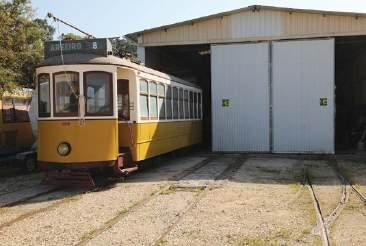
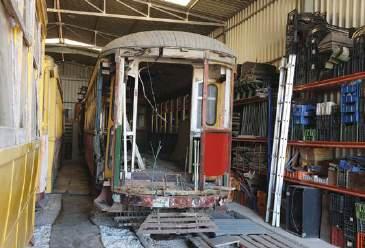

1. Restoration work on bogie car 362 is progressing well. This car is a personal favourite of Paulo’s son, and ownership of it has been transferred to him.
2. Car 326 on the external depot track at the museum, with the car shed in the background.
3. An interior view of the restoration of bogie car 326, showing the full set of 2+2 seating now fitted with cane rattan covering.
4. Bogie car 326 gingerly inches out of the ‘bogie car shed’ for a brief sojourn in the warm Portuguese sunlight. Mobile cabling allows cars at the front of the depot to be moved under their own power for a short distance.
5. Restored bogie car 326 on part of the external track layout at the new premises.
6. Work in progress in the depot, with car 353 undergoing heavy restoration and a small part of the collection of spare parts that Paulo has built up to facilitate authentic work.
7. Car 361 will be one of the next in the restoration queue. This is the tram once acquired by the Black Country Living Museum at Dudley and later repatriated to Portugal. The damage to the two lower panels occurred during transportation to the site and unloading.
8. A glimpse inside the ‘bogie car shed’ with car 362, the last of the 1907 delivery of cars from John Stephenson & Company of New York.


By Paul Rowen
The Association returns to the city of Sheffield in early October for the AGM weekend. The home of Supertram and the UK’s first tram-train operator, SYMCA has just celebrated its ten millionth passenger journey under public ownership.
In addition to the usual formal business of approving the annual accounts, reports from officers and elections to Council, several events and opportunities to meet and discuss transport-related topics have been organised.
The weekend opens on the Friday night with a visit and reception to the South Yorkshire Transport Museum. This is a volunteer-owned museum located in Rotherham which opened in 1995.
The museum is home to around 50 vehicles including cars, buses and ‘Tram 460’, a 1926 Cravens. We will be given a guided tour of the museum followed by a buffet. Transport is included from Sheffield to the museum and back again.
On Saturday morning, members will have an opportunity to ride the Supertram system, before the AGM commences at 14.00 in the Mercure Sheffield St. Paul’s Hotel. This is a five-minute walk from Sheffield station. Prior to the AGM, the usual soup and sandwich lunch will be provided.
Following the formal proceedings it is planned to have a speaker from Supertram to update members on future plans for the system. This will be followed by the AGM dinner, also in the Mercure St Paul’s.
Sunday will begin with a visit to the National Tramway Museum in Crich –there will be a coach from central Sheffield to Crich. Entrance to the museum is free to members – one of the many LRTA member benefits. To facilitate those wanting to return home on Sunday the coach will stop at Derby railway station before returning to Sheffield.
On Monday it is planned to have a visit to the Supertram depot.
No hotel rooms have been booked as there are plenty of hotels in the city, so members are free to make their own arrangements.
Full details and an application form to book events can be found on the LRTA website or on the flyer that came with this magazine.

AUGUST
Wednesday 13. Sussex 19.40. John Bishop: The Bishop heads east. Southwick Community Centre, BN42 4TE. sussex@tlrs.info. £2. (TLRS)
Saturday 16-Sunday 17. Crich 10.0017.00. Model tram, bus and railway exhibition. The National Tramway Museum, DE4 5DP. Contact: john. huddlestone@tramway.co.uk. Cost: £25, child: £15 & family: £55. (CTV) Monday 18. Solent 19.30. TBA. St. Nicholas’s Church Hall,
PO17 6HP. Contact Paul Coles: solent@tlrs.info £2. (TLRS)
Saturday 30. Nottingham 14.00. Bring a thing. Beeston Scout Hut, NG9 1GA. chairman@tlrs.info. (TLRS) Saturday 30. Coatbridge, 13.00. Scottish trams show & tell, plus talk Contact: scotland@tlrs.info (TLRS)
Tuesday 2. Southampton 19.30. Martin Petch: A 1983 tour of Swiss tramways/light railways. Junction
Compiled by the LRTA. For a full list
Church, Eastleigh, GBP3. (LRTA/SEG) Thursday 4. Brentford 14.30. Alan Holmewood: Trams in the Netherlands. London Museum of Water and Steam, TW8 0EN. Contact: thamesvalley@tlrs.info. £5. (TLRS) Wednesday 10. Susse x 19.40. Brian Jackson; Brian’s Mystery Surprise. Southwick Community Centre, BN42 4TE. Contact: sussex@tlrs.info. GBP2 visitors. (SEG) Monday 15. Solent 19.30: TBA St. Nicholas’s Church Hall, PO17 6HP. Contact Paul Coles (Chairman):
visit www.lrta.org
solent@tlrs.info GBP2. (TLRS) Saturday 27. Coatbridge, 13.00. Scottish trams show & tell, plus talk TBC. Cumbernauld Theatre, G67 2UF. Contact scotland@tlrs.info. (TLRS) Saturday 27. Garstang 14.00 Ray Wilkinson: Video tours. St Thomas New Church Hall, PR3 1PA. Contact: archivist@tlrs.info. Small fee, light refreshments. (TLRS) Saturday 27. Nottingham 14.00. Modelling session. Beeston Scout Hut, NG9 1GA. Contact: chairman@tlrs.info. (TLRS)

Order online from www.lrta.info/shop – or by post from:
LRTA Publications, 38 Wolseley Road, SALE, M33 7AU (Please provide telephone contact details and quote LRTA membership number if applicable)
Outside UK = Airmail to Europe (includes all of Russia) / Surface mail to rest of world; Airmail Zone 1 = outside Europe excluding Australia, New Zealand & USA; Airmail Zones 2/3 = Australia, New Zealand & USA

Buses, Trams and Trolleybuses A Photographic Review
A superb collection of images from the late-1940s through to 1970, showcasing the transformation of London Transport’s operations with the demise of both its tram and trolleybus fleets.
> A4 hardback; 192 pages, 350+ black & white pictures.
£44.00 (UK); £57.00 (outside UK); £72.00 (Airmail Z1); £76.50 (Airmail Z2/3); LRTA Members: £4.00 discount
U-Bahn, S-Bahn & Tram in Warszawa Urban Rail in the Polish Capital Warsaw

A new volume in the series of Robert Schwandl books, covering tramways, underground and suburban rail lines. German and English text.
> B5 softback, 128 pages, 300+ colour pictures, 14 maps.
£28.50 (UK); £32.50 (outside UK);
£35.50 (Airmail Z1); £37.50 (Airmail Z2/3); LRTA Members: £2.30 discount
Tramways and Light Railways of Barcelona, Mallorca and Valencia in Colour (1954-1980)

The first in a series of three books covering many of the tramways and electric light railways operational in Spain in the mid-1950s.
> A4 hardback, landscape format; 144 pages, fully illustrated in colour throughout.
£42.50 (UK); £54.00 (outside UK); £66.00 (Airmail Z1); £67.50 (Airmail Z2/3); LRTA Members: £3.90 discount
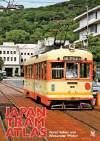
A comprehensive review of the tramways and trolleybuses of Japan with superb track maps for every system. Details of the car types operated and the routes on which they run are covered. English and German text.
> A4 softback; 272 pages, 423 colour and black & white pictures, 48 track maps.
£36.50 (UK); £46.50 (outside UK); £56.50 (Airmail Z1); £61.50 (Airmail Z2/3); LRTA Members: £3.25 discount
For further details of all these books go to our website.
Order direct from the website shown (not from the LRTA)
Die Straβenbahn in Bochum Unterwegs rund um den Kuhhirten seit 1894

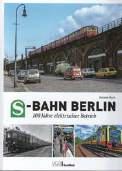
Detailed history of tramways in this industrial Ruhr city and their modernisation to form today’s extensive metre- and standard-gauge networks. German text.
> B5 hardback; 160 pages, 180 colour and black & white pictures, five maps.
£23.88 – www.amazon.co.uk
S-Bahn Berlin
100 Jahre elektrischer Betrieb
Published to mark the centenary of the start of the electrification of the German capital’s extensive S-Bahn system. Its turbulent history during the years of the DDR is covered, and the renaissance of the network following re-unification. German text.
> A4 hardback; 192 pages, 200+ mainly colour pictures, fold-out maps. EUR34.99 – www.amazon.de
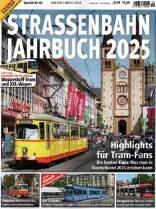
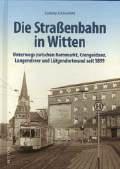
Strassenbahn Jahrbuch 2025
Strassenbahn Magazin Special No. 40
The annual review of tram systems in German-speaking countries with brief reviews from the rest of the world. Features on fifty years ago and tramway museums. German text.
> A4 softback; 116 pages, 300+ colour pictures.
EUR 19.90 – www.amazon.co.uk
Die Straβenbahn in Witten Unterwegs zwischen Kornmarkt, Crengeldanz, Langendreer und Lütgendortmund seit 1899
Relates the complex history of a significant survivor in Germany’s huge array of Ruhr region tramways. German text.
> B5 hardback; 160 pages, 200 colour and black & white pictures, 5 maps. £23.88 – www.amazon.co.uk










